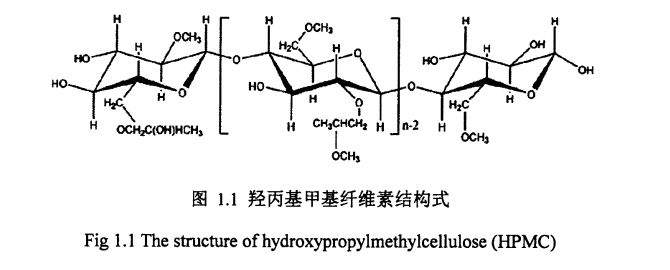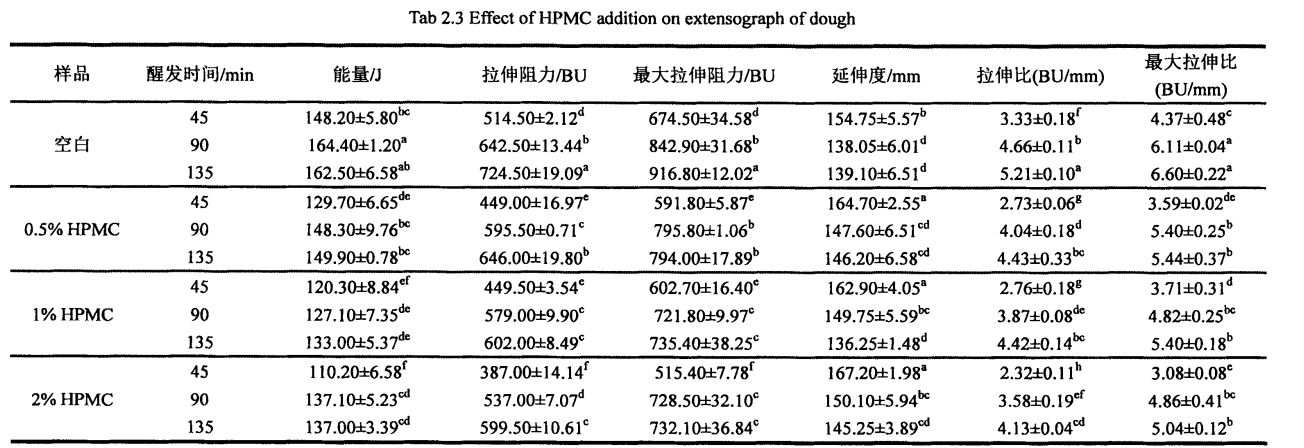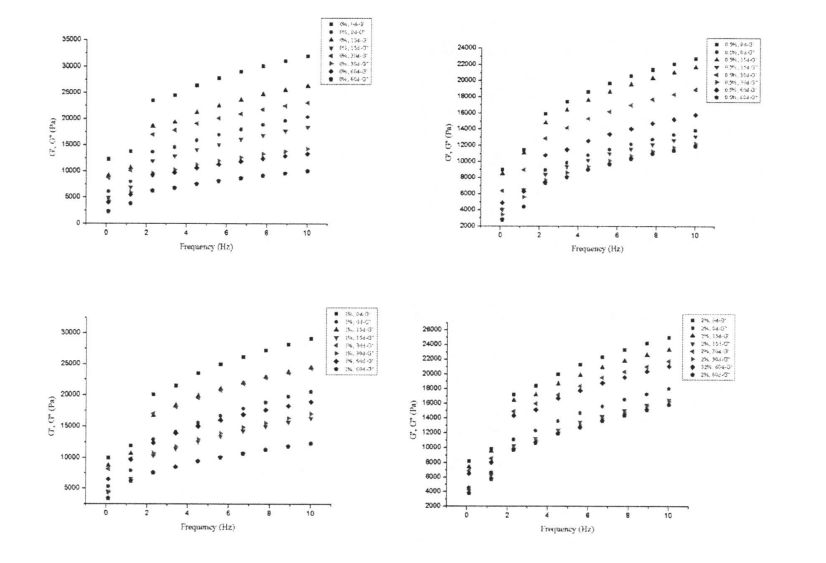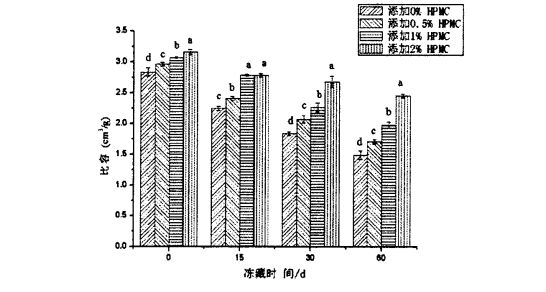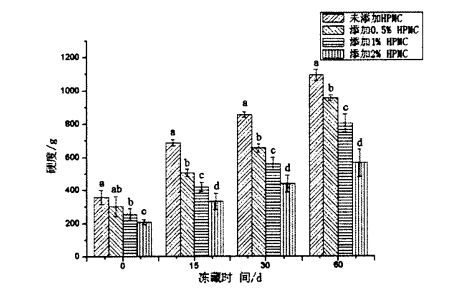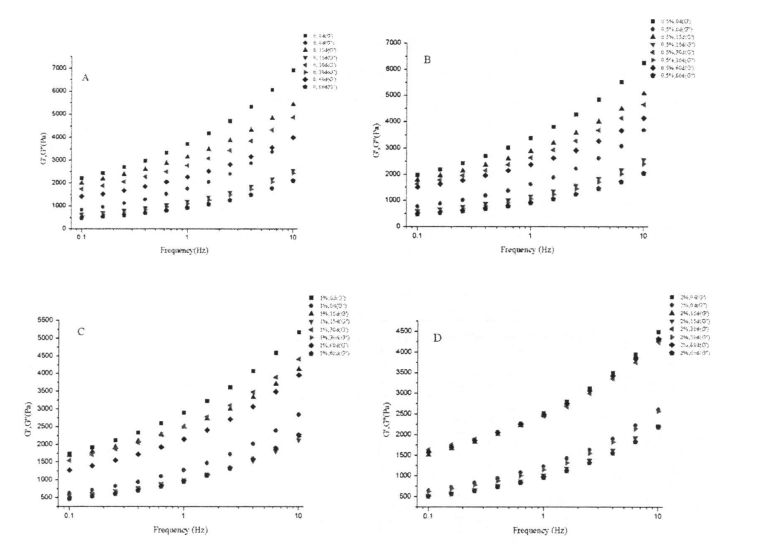Wheat gluten is the material basis for the formation of dough network structure. Experiments found that the addition of I--IPMC reduced the breakage of Yd and disulfide bonds between wheat gluten proteins during frozen storage. ඊට අමතරව, අඩු ක්ෂේත්රයේ න්යෂ්ටික චුම්බක අනුනාදයන් සහ අවකල්ය පරිලෝකනය කිරීමේ ප්රති results ල ජල රාජ්ය සංක්රාන්ති හා ප්රතිස්ථාපන සංස්ථාගත කිරීම සීමිත වන අතර, ඇනූ වල ඇති කැටි වතුරේ අන්තර්ගතය ග්ලූටන් ක්ෂුද්ර ව්යුහය සහ එහි අවකාශීය අනුකූලතාවයේ බලපෑම අඩු කරයි. Scanning electron microscope showed intuitively that the addition of HPMC could maintain the stability of gluten network structure.
අන්තර්ගත වගුව
1.1.2 Research status of steamed buns……………………………………………… . . ………… 1
1.1.7 Hydroxypropyl methyl cellulose (Hydroxypropyl methyl cellulose, I-IPMC) ………. 5
112 අධ්යයනයේ අරමුණ හා වැදගත්කම ....................................................................................................................................................................................................................................................................................................................................................................................................................................................................................
2.2.1 පර්යේෂණාත්මක ද්රව්ය ........................................................................................................................................
2.3 පර්යේෂණාත්මක ප්රති results ල සහ සාකච්ඡාව .............................................................................................................................................................................................................................................................................................................. 11
3.2.4 Experimental methods ....................................................................................................... 25
3.3.2 The effect of adding amount of HPMC and freezing storage time on the freezable moisture content (CFW) and thermal stability……………………………………………………………………. 30
3.3. . 34
3.3.
3.4 පරිච්ඡේද සාරාංශය ..................................................................................................................................................................
Chapter 4 Effects of HPMC addition on starch structure and properties under frozen storage conditions………………………………………………………………………………………………………………………… 44
4.1 Introduction .............................................................................................................................. . 44
4.2 පර්යේෂණාත්මක ද්රව්ය හා ක්රම ......................................................................................................................... 45
4.3 Analysis and discussion ........................................................................................................... 48
4.3.1 තිරිඟු පිෂ් ch යෙහි මූලික කොටස්වල අන්තර්ගතය ................................................................................ 48
4.3.2 Effects of I-IPMC addition amount and frozen storage time on the gelatinization characteristics of wheat starch……………………………………………………………………………………………….48
4.3.3 Effects of HPMC addition and freezing storage time on the shear viscosity of starch paste………………………………………………………………………………………………………………………………………. 52
4.3.6 Effects of I-IPMC addition amount and frozen storage time on the thermodynamic properties of starch ………………………………………………………………………………………………………. . 57
4.4 පරිච්ඡේද සාරාංශය ...................................................................................................................................... 6 1
Chapter 5 Effects of HPMC addition on yeast survival rate and fermentation activity under frozen storage conditions………………………………………………………………………………………………. . 62
5.1Introduction .................................................................................................................................... 62
5.2 Materials and methods ............................................................................................................ 62
5.2.2 Experimental methods . . . . . …………………………………………………………………………. 63
5.3 Results and Discussion ............................................................................................................... 64
5.3.2 එච්.පී.එම්.සී.
5.3.3 The effect of adding amount of HPMC and freezing time on the content of glutathione in dough……………………………………………………………………………………………………………66. "
5.4 Chapter Summary ........................................................................................................................ 67
6.1 Conclusion ................................................................................................................................. . 68
6.2 Outlook .......................................................................................................................................... 68
නිදර්ශන ලැයිස්තුව
රූපය 1.1 හයිඩ්රොක්සිප්රොපයිල් මෙතිල්ක්රිලොයිස් හි ව්යුහාත්මක සූත්රය .............................. . 6
Figure 2.1 The effect of HPMC addition on the rheological properties of frozen dough…………………………………………………………………………………………………………………………………….. 15
Figure 2.2 Effects of HPMC addition and freezing time on specific volume of steamed bread……………………………………………………………………………………………………………………………………... 18
Figure 2.4 The effect of HPMC addition and freezing time on the elasticity of steamed bread………………………………………………………………………………………………………………………………. . 20
Figure 3.1 The effect of HPMC addition and freezing time on the rheological properties of wet gluten…………………………………………………………………………………………………………………………. 30
Figure 3.2 Effects of HPMC addition and freezing time on the thermodynamic properties of wheat gluten………………………………………………………………………………………………………………. . 34
Figure 3.3 Effects of HPMC addition and freezing time on free sulfhydryl content of wheat gluten……………………………………………………………………………………………………………………………... . 35
Figure 3.4 Effects of HPMC addition amount and freezing storage time on the distribution of transverse relaxation time (n) of wet gluten………………………………………………………………………36
Figure 3.5 Wheat gluten protein infrared spectrum of the amide III band after deconvolution and second derivative fitting………………………………………………………………………... 38
Figure 3.6 Illustration ................................................................................................................ ……….39
Figure 3.7 The effect of HPMC addition and freezing time on the microscopic gluten network structure…………………………………………………………………………………………………………... . 43
Figure 4.1 Starch gelatinization characteristic curve ............................................................... 51
Figure 4.2 Fluid thixotropy of starch paste ................................................................................. 52
Figure 4.3 Effects of adding amount of MC and freezing time on the viscoelasticity of starch paste……………………………………………………………………………………………………………………... . 57
Figure 4.5 Effects of HPMC addition and freezing storage time on the thermodynamic properties of starch…………………………………………………………………………………………………………. . 59
Figure 5.2 The effect of HPMC addition and freezing time on the yeast survival rate…………………………………………………………………………………………………………………………………... . 67
Figure 5.3 Microscopic observation of yeast (microscopic examination) …………………………………………………………………………………………………………………………. 68
පෝරම ලැයිස්තුව
Table 2.1 The basic ingredient content of wheat flour…………………………………………………. 11
වගුව 2.3 ඇනූ ආතන්ය දේපලවලට I-IPMC හි බලපෑම .......................................
Table 3.2 Effects of I-IPMC addition amount and freezing storage time on the phase transition enthalpy (Yi IV) and freezer water content (e chat) of wet gluten………………………. 31
Table 3.3 Effects of HPMC addition amount and freezing storage time on the peak temperature (product) of thermal denaturation of wheat gluten…………………………………………. 33
Table 3.6 Effects of I-IPMC addition and freezing storage time on the surface hydrophobicity of wheat gluten……………………………………………………………………………………………. 41
Table 4.3 Effects of I-IPMC addition and freezing time on the shear viscosity of wheat starch paste…………………………………………………………………………………………………………………………. 55
මේ වන විට, තැම්බූ පාන් පිළිබඳ පර්යේෂණ ප්රධාන වශයෙන් පහත සඳහන් අංග කෙරෙහි අවධානය යොමු කරයි:
1)Development of new characteristic steamed buns. Through the innovation of steamed bread raw materials and the addition of functional active substances, new varieties of steamed breads have been developed, which have both nutrition and function. Established the evaluation standard for the quality of miscellaneous grain steamed bread by principal component analysis; Fu et a1. (2015) added lemon pomace containing dietary fiber and polyphenols to steamed bread, and evaluated the antioxidant activity of steamed bread; Hao & Beta (2012) studied barley bran and flaxseed (rich in bioactive substances) The production process of steamed bread [5]; ෂියාඕ සහ ඒ ඒ 1. (2015) evaluated the effect of adding pineapple pulp fiber on dough rheological properties and steamed bread quality [6].
2)Research on the processing and compounding of special flour for steamed bread. The effect of flour properties on the quality of dough and steamed buns and the research on new special flour for steamed buns, and based on this, an evaluation model of flour processing suitability was established [7]; උදාහරණයක් ලෙස, පිටි හා තැම්බූ බනිස් වල ගුණාත්මකභාවය පිළිබඳ විවිධ පිටි ඇඹරුම් ඇඹරුම් ක්රමවල බලපෑම [7] 81; තැම්බූ පාන් වල ගුණාත්මකභාවය මත ඉටි තිරිඟු පිටි කිහිපයක් සංයුක්ත කිරීමේ බලපෑම [9J et අල්; Zhu, Huang, &Khan (2001) evaluated the effect of wheat protein on the quality of dough and northern steamed bread, and considered that gliadin/ Glutenin was significantly negatively correlated with dough properties and steamed bread quality [lo]; ෂැං, සහ 1. (2007) analyzed the correlation between gluten protein content, protein type, dough properties and steamed bread quality, and concluded that the content of high molecular weight glutenin subunit (1ligh.molecular-weight, HMW) and total protein content are all related to the quality of northern steamed bread. සැලකිය යුතු බලපෑමක් ඇති කරයි [11].
3)Research on dough preparation and steamed bread making technology. Research on the influence of steamed bread production process conditions on its quality and process optimization; Liu thanghong et al al. (2009) showed that in the process of dough conditioning, process parameters such as water addition, dough mixing time, and dough pH value have an impact on the whiteness value of steamed bread. It has a significant impact on sensory evaluation. If the process conditions are not suitable, it will cause the product to turn blue, dark or yellow. The research results show that during the dough preparation process, the amount of water added reaches 45%, and the dough mixing time is 5 minutes, ~ When the pH value of the dough was 6.5 for 10 min, the whiteness value and sensory evaluation of the steamed buns measured by the whiteness meter were the best. When rolling the dough 15-20 times at the same time, the dough is flaky, smooth, elastic and shiny surface; when the rolling ratio is 3:1, the dough sheet is shiny, and the whiteness of the steamed bread increases [l to; Li, et a1. (2015) explored the production process of compound fermented dough and its application in steamed bread processing [13].
5)Preservation and anti-aging of steamed bread and related mechanisms. Pan Lijun et al. (2010) optimized the composite modifier with good anti-aging effect through experimental design [l do not; වැන්ග්, සහ සහ 1. (2015) studied the effects of gluten protein polymerization degree, moisture, and starch recrystallization on the increase of steamed bread hardness by analyzing the physical and chemical properties of steamed bread. The results showed that water loss and starch recrystallization were the main reasons for the aging of steamed bread [20].
6) නව පැසුණු බැක්ටීරියා සහ ඇඹුල් භාවිතා කිරීම පිළිබඳ පර්යේෂණ. Jiang, et a1. (2010) Application of Chaetomium sp. fermented to produce xylanase (with thermostable) in steamed bread [2l'; Gerez, et a1. (2012) used two kinds of lactic acid bacteria in fermented flour products and evaluated their quality [221; Wu, et al. (2012) studied the influence of sourdough fermented by four kinds of lactic acid bacteria (Lactobacillus plantarum, Lactobacillus, sanfranciscemis , Lactobacillus brevis and Lactobacillus delbrueckii subsp bulgaricus) on the quality (specific volume, texture, fermentation flavor, etc.) of northern steamed bread [23]; and Gerez, et a1. (2012) used the fermentation characteristics of two kinds of lactic acid bacteria to accelerate the hydrolysis of gliadin to reduce the allergenicity of flour products [24] and other aspects.
Among them, steamed bread is prone to aging under conventional storage conditions, which is an important factor restricting the development of steamed bread production and processing industrialization. After aging, the quality of steamed bread is reduced - the texture becomes dry and hard, dregs, shrinks and cracks, the sensory quality and flavor deteriorate, the digestion and absorption rate decreases, and the nutritional value decreases. මෙය එහි රාක්කයේ ජීවිතයට පමණක් බලපානවා පමණක් නොව, අපද්රව්ය විශාල ප්රමාණයක් ද නිර්මාණය කරයි. According to statistics, the annual loss due to aging is 3% of the output of flour products. 7%. With the improvement of people's living standards and health awareness, as well as the rapid development of the food industry, how to industrialize the traditional popular staple noodle products including steamed bread, and obtain products with high quality, long shelf life and easy preservation to meet the needs of the growing demand for fresh, safe, high-quality and convenient food is a long-standing technical problem. මෙම පසුබිම මත පදනම්ව, ශීත කළ පිටි ගුලිය සිදු වූ අතර එහි වර්ධනය තවමත් අත්හිටුවෙමින් පවතී.
1.1.3 ශීත කළ පිටි ගුලිය දක්වා හඳුන්වාදීම
The emergence of frozen dough not only creates conditions for the industrialization, standardization, and chain production of fermented pasta products, it can effectively shorten processing time, improve production efficiency, and reduce production time and labor costs. Therefore, the aging phenomenon of the pasta food is effectively inhibited, and the effect of prolonging the shelf life of the product is achieved. එබැවින්, විශේෂයෙන් යුරෝපයේ, ඇමරිකාවේ, ජපානය සහ වෙනත් රටවල, ශීත කළ පිටි ගුලිය, ප්රංශ මිහිරි පාන් (ප්රංශ මිහිරි පාන්), කුඩා මෆින් (මෆින්), ප්රංශ බෑගට් (- සැරයටිය), කුකීස් සහ ශීත කළ
Most studies have found that the formation and growth of ice crystals in frozen foods is an important factor leading to the deterioration of product quality [291]. Ice crystals not only reduce the survival rate of yeast, but also weaken the gluten strength, affect the starch crystallinity and gel structure, and damage the yeast cells and release the reducing glutathione, which further reduces the gas holding capacity of gluten. ඊට අමතරව, ශීත කළ ආචයනය සම්බන්ධයෙන් ගත් කල, උෂ්ණත්ව උච්චාවචනයන් නැවත ප්රතිස්ථාපනය කිරීම නිසා අයිස් ස් st ටික වැඩීමට හේතු විය හැක [30]. Therefore, how to control the adverse effects of ice crystal formation and growth on starch, gluten and yeast is the key to solving the above problems, and it is also a hot research field and direction. පසුගිය වසර දහය තුළ, බොහෝ පර්යේෂකයන් මෙම කාර්යයේ නිරත වී ඇති අතර ful ලදායී පර්යේෂණ ප්රති .ල කිහිපයක් අත්කර ගෙන තිබේ. කෙසේ වෙතත්, මෙම ක්ෂේත්රයේ හිඩැස් සහ අඛණ්ඩ හා මතභේදාත්මක කරුණු කිහිපයක් තවමත් තිබේ, එය තවදුරටත් ගවේෂණය කළ යුතුය.
a)How to restrain the quality deterioration of frozen dough with the extension of frozen storage time, especially how to control the influence of the formation and growth of ice crystals on the structure and properties of the three main components of dough (starch, gluten and yeast), is still an issue. මෙම පර්යේෂණ ක්ෂේත්රයේ උණුසුම් ස්ථාන සහ මූලික ගැටළු;
Ii. Optimization of frozen dough production process, frozen storage conditions and formula. During the production of frozen dough, temperature control, proofing conditions, pre-freezing treatment, freezing rate, freezing conditions, moisture content, gluten protein content, and thawing methods will all affect the processing properties of frozen dough [37]. පොදුවේ ගත් කල, ඉහළ කැටි කිරීමේ අනුපාත අයිස් ස් st ටික ප්රමාණයෙන් කුඩා වන අතර ප්රමාණය වඩාත් ඒකාකාරව බෙදා හරින අතර අඩු කැටි කිරීමේ අනුපාතයන් ඒකාකාරව බෙදා හරිනු නොලබන අයිස් ස් st ටික විශාල වේ. In addition, a lower freezing temperature even below the glass transition temperature (CTA) can effectively maintain its quality, but the cost is higher, and the actual production and cold chain transportation temperatures are usually small. In addition, the fluctuation of the freezing temperature will cause recrystallization, which will affect the quality of the dough.
III. Using additives to improve the product quality of frozen dough. In order to improve the product quality of frozen dough, many researchers have made explorations from different perspectives, for example, improving the low temperature tolerance of material components in frozen dough, using additives to maintain the stability of the dough network structure [45.56], etc. Among them, the use of additives is an effective and widely used method. Mainly include, i) enzyme preparations, such as, transglutaminase, O [. Amylase; ii) emulsifiers, such as monoglyceride stearate, DATEM, SSL, CSL, DATEM, etc.; iii) antioxidants, ascorbic acid, etc.; iv) polysaccharide hydrocolloids, such as guar gum, yellow Originalgum, gum Arabic, konjac gum, sodium alginate, etc.; v) other functional substances, such as Xu, et a1. (2009) added Ice-structuring Proteins to wet gluten mass under freezing conditions, and studied its protective effect and mechanism on the structure and function of gluten protein [y71.
Due to the existence of hydrogen bonds in the linear molecular chain and crystalline structure, cellulose has poor water solubility, which also limits its application range. However, the presence of substituents on the side chain of HPMC breaks the intramolecular hydrogen bonds, making it more hydrophilic [66l], which can quickly swell in water and form a stable thick colloidal dispersion at low temperatures Tie. As a cellulose derivative-based hydrophilic colloid, HPMC has been widely used in the fields of materials, papermaking, textiles, cosmetics, pharmaceuticals and food [6 71]. In particular, due to its unique reversible thermo-gelling properties, HPMC is often used as a capsule component for controlled release drugs; in food, HPMC is also used as a surfactant, Thickeners, emulsifiers, stabilizers, etc., and play a role in improving the quality of related products and realizing specific functions. For example, the addition of HPMC can change the gelatinization characteristics of starch and reduce the gel strength of starch paste. HPMC ට ආහාරවල තෙතමනය නැතිවීම අඩු කර පාන් හරයේ දෘ ness තාව අඩු කළ හැකි අතර පාන් වයසට යාම වළක්වයි.
Although HPMC has been used in pasta to a certain extent, it is mainly used as an anti-aging agent and water-retaining agent for bread, etc., which can improve product specific volume, texture properties and prolong shelf life [71.74]. කෙසේ වෙතත්, ගුවාර් විදුරුමස්, සන්තොන්හාන් විදුරුමස් සහ සෝඩියම් ඇල්ජිනට් වැනි හයිඩ්රොෆිලික් කොලොට් සමඟ සසඳන විට, ශීත කළ පිටි ගුලියෙන් තැම්බූ පාන් වල ගුණාත්මකභාවය වැඩි දියුණු කළ හැකිද යන්න පිළිබඳ HPMC අත්පොත පිළිබඳ බොහෝ අධ්යයන නොමැත. There is still a lack of relevant reports on its effect.
At present, the application and large-scale production of frozen dough processing technology in my country as a whole is still in the development stage. At the same time, there are certain pitfalls and deficiencies in the frozen dough itself. These comprehensive factors undoubtedly restrict the further application and promotion of frozen dough. අනෙක් අතට, මෙයින් අදහස් කරන්නේ ශීත කළ පිටි ගුලිය යෙදීමෙන් හොඳ විභවයන් සහ පුළුල් අපේක්ෂාවන් ඇති අතර, විශේෂයෙන් ශීත කළ පිටි ගුලියෙහි චීන නවත්ඩු (නොපැමිණෙන ප්රධාන ආහාර නිෂ්පාදනය කිරීම, පැසුණු ප්රධාන ආහාර නිෂ්පාදනය කිරීම, විශේෂයෙන් පැසුණු ප්රධාන ආහාර නිෂ්පාදනය කිරීම, විශේෂයෙන් පැසසුමට ලක්වූ ප්රධාන ආහාර නිෂ්පාදනය කිරීම, විශේෂයෙන් පැසුණු ප්රධාන ආහාර නිපදවීම, විශේෂයෙන් පැසසුමට ලක්වූ ප්රධාන ආහාර නිපදවීම, It is of practical significance to improve the quality of the frozen dough based on the characteristics of Chinese pastry and the dietary habits, and is suitable for the processing characteristics of Chinese pastry.
It is precisely because the relevant application research of HPMC in Chinese noodles is still relatively lacking. Therefore, the purpose of this experiment is to expand the application of HPMC to frozen dough, and to determine the improvement of frozen dough processing by HPMC through the evaluation of steamed bread quality. In addition, HPMC was added to the three main components of the dough (wheat protein, starch and yeast liquid), and the effect of HPMC on the structure and properties of wheat protein, starch and yeast was systematically studied. ශීත කළ පිටි ගුලියෙහි ගුණාත්මකභාවය වැඩි කිරීම සඳහා නව ශල්ය වෛද්යත්ව වැඩිදියුණු කිරීම සඳහා නව ශක්ය මාර්ගයක් සැපයීම සඳහා සහ, තැම්බූ පාන් සෑදීමට සුදුසු ශීත කළ පිටි ගුලිය නිපදවීම සඳහා න්යායාත්මක සහයෝගය ලබා දීම සඳහා එහි අදාළ යාන්ත්රණ ගැටළු සහ න්යායාත්මක සහයෝගය ලබා දීම සඳහා.
එකතු කිරීමේ බලපෑම සහ ශීත කළ පිටි ගුලියෙහි ව්යුහය සහ ගුණාංග පිළිබඳ ශීත කළ ගබඩා කාලය, ශීත කළ ඇනූ නිෂ්පාදනවල ව්යුහය, තිරිඟු ග්ලූටන් වල ව්යුහය සහ ගුණාංග, සහ තිරිඟු පිෂ් of යක ව්යුහය සහ යීස්ට්ගේ පැවරීමේ ක්රියාකාරකම්. Based on the above considerations, the following experimental design was made in this research topic:
Generally speaking, the material composition of dough used for making fermented flour products mainly includes biological macromolecular substances (starch, protein), inorganic water, and yeast of organisms, and is formed after hydration, cross-linking and interaction. A stable and complex material system with a special structure has been developed. Numerous studies have shown that the properties of the dough have a significant impact on the quality of the final product. එමනිසා, විශේෂිත නිෂ්පාදිතය සපුරාලීම සඳහා සංයුක්තකරණය ප්රශස්තිකරණය කිරීමෙන් නිෂ්පාදනයේ ගුණාත්මකභාවය හෝ ආහාරවල ගුණාත්මකභාවය සඳහා ඇනූ සකස් කිරීම හා තාක්ෂණය වැඩි දියුණු කිරීම පර්යේෂණ දිශාවකි; on the other hand, improving or improving the properties of dough processing and preservation to ensure or improve the quality of the product is also an important research issue.
Ta-XT ප්ලස් භෞතික දේපල පරීක්ෂක
Dhg. 9070A Blast Drying Oven
Powder meter. ඊ
Extensometer. ඊ
ඩිස්කවරි ආර් 3 භ්රමණ රයෝමීටරය
FD. 1B. 50 රික්ත කැටි වියළනය
නිෂ්පාදකයා
GB / T 17320.998 හි ඇනූ සෑදීමේ ක්රියාවලිය ගැන සඳහන් කරන්න [84]. පිටි ග්රෑම් 450 ග්රෑම් සහ ඇනූ මික්සර් බඳුන තුළට ඇනූ විට අක්රීය වියළි යීස්ට් ග්රෑම් 5 ක්, පසුව මිනිත්තු 1 ක් අඩු වේගයකින් බීට් කරන්න. / portion, knead it into a cylindrical shape, then seal it with a ziplock bag, and put it in. Freeze at 18°C for 15, 30, and 60 days. Add 0.5%, 1%, 2% (w/w, dry basis) HPMC to replace the corresponding proportion of flour quality to make dough, and the rest of the production methods remain unchanged. The 0-day frozen storage (unfrozen storage) was used as the control experimental group.
අනුරූප කැටි කිරීමේ වේලාවෙන් පසු ඇනූ සාම්පල ඉවත් කරන්න, ඒවා පැය 4 ක් සඳහා ශීතකරණයක් තුළ 4 ° C දී තබන්න, ඉන්පසු ඇනූ සාම්පල සම්පූර්ණයෙන්ම දියවන තෙක් ඒවා උෂ්ණත්වයේ තබන්න. The sample processing method is also applicable to the experimental part of 2.3.6.
අර්ධ වශයෙන් උණු කළ ඇනූ වල මධ්යම කොටසෙහි (ග්රෑම් 2 ක් පමණ) සාම්පලයක් කපා රයිසෙටරයේ පහළ තහඩුව මත තබා ඇත (සොයා ගැනීම R3). First, the sample was subjected to dynamic strain scanning. The specific experimental parameters were set as follows: A parallel plate with a diameter of 40 mm was used, the gap was set to 1000 mln, the temperature was 25 °C, and the scanning range was 0.01%. 100%, the sample rest time is 10 min, and the frequency is set to 1Hz. The Linear Viscoelasticity Region (LVR) of the tested samples was determined by strain scanning. Then, the sample was subjected to a dynamic frequency sweep, and the specific parameters were set as follows: the strain value was 0.5% (in the LVR range), the resting time, the fixture used, the spacing, and the temperature were all consistent with the strain sweep parameter settings. Five data points (plots) were recorded in the rheology curve for each 10-fold increase in frequency (linear mode). After each clamp depression, the excess sample was gently scraped with a blade, and a layer of paraffin oil was applied to the edge of the sample to prevent water loss during the experiment. Each sample was repeated three times.
2.2.3.6 කැටි වතුරේ අන්තර්ගතය (කැටි කළ හැකි ජලයේ අන්තර්ගතය, සීඑෆ් අභ්යන්තර අධිෂ් ed ානය) ඇනූ
Weigh a sample of about 15 mg of the central part of the fully melted dough, seal it in an aluminum crucible (suitable for liquid samples), and measure it with a Differential Scanning Calorimetry (DSC). The specific program parameters are set. පහත පරිදි: මිනිත්තු 5 ක් සඳහා මුලින්ම 20 ° C දී සමතුලිත කර, මිනිත්තු 10 ක අනුපාතයකින්, මිනිත්තු 10 ක අනුපාතයකින්, පිරිසිදු කිරීමේ වායුව අවම මිලි ලීටර් 50 යි. Using the blank aluminum crucible as a reference, the obtained DSC curve was analyzed using the analysis software Universal Analysis 2000, and the melting enthalpy (day) of the ice crystal was obtained by integrating the peak located at about 0°C. කැටි වූ ජල අන්තර්ගතය (CFW) ගණනය කරනු ලබන්නේ පහත සූත්රය [85.86]:
අනුරූප කැටි කිරීමේ වේලාවෙන් පසු, ශීත කළ පිටි ගුලිය පිටතට ගෙන ගිය අතර, පළමුව පැය 4 ක් සඳහා 4 ° C ශීතකරණයක් තුළ සමතුලිත වූ අතර ශීත කළ පිටි ගුලිය සම්පූර්ණයෙන්ම දියවන තෙක් කාමර උෂ්ණත්වයේ තබා ඇත. Divide the dough into about 70 grams per portion, knead it into shape, and then put it into a constant temperature and humidity box, and proof it for 60 minutes at 30°C and a relative humidity of 85%. After proofing, steam for 20 min, and then cool for 1 h at room temperature to evaluate the quality of steamed bread.
2.2.3.8 තැම්බූ පාන් වල ගුණාත්මකභාවය තක්සේරු කිරීම
GB / T 20981.2007 ට අනුව [871, තැම්බූ බනිස් වල පරිමාව (වැඩ) මැනීම සඳහා (වැඩ) විසින් වාෂ්ප බනිස්ගේ ස්කන්ධය මනිනු ලැබීය. Each sample was replicated three times.
Refer to the method of Sim, Noor Aziah, Cheng (2011) [88] with minor modifications. තැම්බූ පාන් වල මධ්යම ප්රමාණයෙන් 20x 20 x 20 mn13 කෝර් නියැදිය, තැම්බූ පාන් වල TPA (වයනය පැතිකඩ විශ්ලේෂණය) භෞතික දේපල පරීක්ෂකයෙකු විසින් මනිනු ලැබීය. Specific parameters: the probe is P/100, the pre-measurement rate is 1 mm/s, the mid-measurement rate is 1 mm/s, the post-measurement rate is 1 mm/s, the compression deformation variable is 50%, and the time interval between two compressions is 30 S, the trigger force is 5 g. Each sample was repeated 6 times.
J (2% HPMC added). ඒ අතරම, ඇනූ වල උපරිම ආතන්ය ප්රතිරෝධය 674.50 - A: 34.58 BU (හිස්) සිට 591.80 දක්වා - A: 5% HPMC එකතු කිරීම), සහ 515.5.0 A: 7.78 B (2% HPMC එකතු කරන ලදි). However, the elongation of the dough increased from 154.75+7.57 MITI (blank) to 164.70-a: 2.55 m/rl(adding 0.5% HPMC), 162.90-a: 4 .05 min (1% HPMC added), and 1 67.20-a: 1.98 min (2% HPMC added). This may be due to the increase of the plasticizer-water content by adding HPMC, which reduces the resistance to the deformation of the gluten protein molecular chain, or the interaction between HPMC and the gluten protein molecular chain changes its stretching behavior, which in turn affects It improves the tensile properties of the dough and increases the extensibility of the dough, which will affect the quality (eg, specific volume, texture) of the final product.
රූප සටහන 2.1 දින 0 සිට 60 දක්වා ආම්බුලේ ආකෘතිකරණය (ප්රත්යාස්ථ මාපාංකය, ජී ') සහ අලාභ මාපාංකය (එච්.පී.එම්. ඇනූ හි ජාල ව්යුහය අයිස් ස් st ටික මගින් අයිස් ස් st ටික මගින් හානියට පත් වීම නිසා එහි ව්යුහාත්මක ශක්තිය අඩු වන අතර, ඒ අනුව ප්රත්යාස්ථතා මාපාංකය සැලකිය යුතු ලෙස අඩු වේ. කෙසේ වෙතත්, HPMC එකතු කිරීමේ වැඩිවීමත් සමඟ, G 'හි විචලනය ක්රමයෙන් අඩු විය. විශේෂයෙන්, HPMC හි අමතර HPMC ප්රමාණය 2% ක් වූ විට, G 'හි විචලනය කුඩාම විය. මෙයින් පෙනී යන්නේ HPMC විසින් අයිස් ස් st ටික සෑදීමෙන් හා අයිස් ස් st ටික ප්රමාණයෙහි ප්රමාණයට effectively ලදායී ලෙස වළක්වා ගත හැකි අතර එමඟින් ඇනූ ව්යුහයට වන හානිය අවම කර ඇනූ වල ව්යුහාත්මක ශක්තිය පවත්වා ගැනීම. In addition, the G' value of dough is greater than that of wet gluten dough, while the G" value of dough is smaller than that of wet gluten dough, mainly because the dough contains a large amount of starch, which can be adsorbed and dispersed on the gluten network structure. It increases its strength while retaining excess moisture.
Not all the moisture in the dough can form ice crystals at a certain low temperature, which is related to the state of the moisture (free-flowing, restricted, combined with other substances, etc.) and its environment. අඩු උෂ්ණත්වවලදී අයිස් ස් st ටික සෑදීම සඳහා අදියර පරිණාමනය කළ හැකි ඇනූ වල කැටි ජලයයි. The amount of freezable water directly affects the number, size and distribution of ice crystal formation. In addition, the freezable water content is also affected by environmental changes, such as the extension of freezing storage time, the fluctuation of freezing storage temperature, and the change of material system structure and properties. HPMC එකතු නොකළ ශීත කළ පිටි ගුලිය සඳහා, කැටි ගබඩා කාලය දීර් q, Q සිලිකන් 32.48 ± 0.32% (දින 0 ක් සඳහා ශීත කළ ආචයනය) සිට 39.13 ± 0.64% (දින 0 ක් සඳහා ශීත කළ ආචයනය). Tibetan for 60 days), the increase rate was 20.47%. However, after 60 days of frozen storage, with the increase of HPMC addition, the increase rate of CFW decreased, followed by 18.41%, 13.71%, and 12.48% (Table 2.4). At the same time, the o∥ of the unfrozen dough decreased correspondingly with the increase of the amount of HPMC added, from 32.48a-0.32% (without adding HPMC) to 31.73±0.20% in turn. (adding0.5% HPMC), 3 1.29+0.03% (adding 1% HPMC) and 30.44±0.03% (adding 2% HPMC) Water holding capacity, inhibits the free flow of water and reduces the amount of water that can be frozen. In the process of freezing storage, along with recrystallization, the dough structure is destroyed, so that part of the non-freezable water is converted into freezable water, thus increasing the content of freezable water. කෙසේ වෙතත්, HPMC විසින් අයිස් ස් st ටික සෑදීමෙන් හා වර්ධනය කිරීම සඳහා effectively ලදායී ලෙස වළක්වා ගත හැකි අතර ඇනූ ව්යුහයේ ස්ථායිතාව ආරක්ෂා කිරීම සහ එමඟින් කැටි ජල අන්තර්ගතයන් වැඩි කිරීම වළක්වයි. This is consistent with the change law of the freezable water content in the frozen wet gluten dough, but because the dough contains more starch, the CFW value is smaller than the G∥ value determined by the wet gluten dough (Table 3.2).
2.3.6 මම වාෂ්ප පාන් වල ගුණාත්මකභාවය පිළිබඳ කැමැත්ත සහ කැටි කාලය තුළ ඇති කාලය
2.3.6.1 HPMC එකතු කිරීමේ අතිරේක මුදල සහ තැම්බූ පාන් විශේෂිත පරිමාව පිළිබඳ ශීත කළ ගබඩා කාලය
However, the specific volume of the steamed bread made from frozen dough decreased with the extension of the frozen storage time. ඒ අතර, HPMC එකතු කිරීමකින් තොරව ශීත කළ ඇනූ වලින් සාදන ලද තැම්බූ පාන් වල නිශ්චිත පරිමාව 2.835 ± 0.064 cm3 / g (ශීත කළ ආචයනය) විය. 0 days) down to 1.495±0.070 cm3/g (frozen storage for 60 days); ශීත කළ පිටි ගුලියකින් සාදන ලද ස්ට්රෝම් පාන් වල නිශ්චිත පරිමාව 2% HPMC සමඟ 3.160 ± 0.041 cm3 / g සිට 2.160 ± 0.041 cm3 / g දක්වා පහත වැටුණි. 451 ± 0.033 cm3 / g, එබැවින්, ශීත කළ පිටි ගුලියෙන් සාදන ලද පාන් වල නිශ්චිත පරිමාව HPMC සමඟ එකතු කරන ලද අතර එකතු කරන ලද ප්රමාණයේ එකතු වූ මුදල වැඩිවීමත් සමඟ අඩු විය. Since the specific volume of steamed bread is not only affected by the yeast fermentation activity (fermentation gas production), the moderate gas holding capacity of the dough network structure also has an important impact on the specific volume of the final product [96'9 cited. The measurement results of the above rheological properties show that the integrity and structural strength of the dough network structure are destroyed during the freezing storage process, and the degree of damage is intensified with the extension of the freezing storage time. During the process, its gas holding capacity is poor, which in turn leads to a decrease in the specific volume of the steamed bread. However, the addition of HPMC can more effectively protect the integrity of the dough network structure, so that the air-holding properties of the dough are better maintained, therefore, in O. During the 60-day frozen storage period, with the increase of HPMC addition, the specific volume of the corresponding steamed bread decreased gradually.
TPA (Textural Profile Analyses) physical property test can comprehensively reflect the mechanical properties and quality of pasta food, including hardness, elasticity, cohesion, chewiness and resilience. Figure 2.3 shows the effect of HPMC addition and freezing time on the hardness of steamed bread. The results show that for fresh dough without freezing treatment, with the increase of HPMC addition, the hardness of steamed bread significantly increases. 355.55 ± 245G 24.35G (හිස් සාම්පල) සිට 310.48 ± 20.09 (2%% hpmc) සහ 215.29 + 997 ග්රෑම් (2% ටී-අයිපීඑම්සී) (2% HPMC එකතු කරන්න) (2% HPMC එකතු කරන ලදි). This may be related to the increase in specific volume of steamed bread. In addition, as can be seen from Figure 2.4, as the amount of HPMC added increases, the springiness of steamed bread made from fresh dough increases significantly, from 0.968 ± 0.006 (blank) to 1, respectively. .020 ± 0.004 (0.5% HPMC එකතු කරන්න), 1.073 ± 0.006 (1% I-IPMC) සහ 1.176 ± 0.003 (2% HPMC එකතු කරන්න). The changes of the hardness and elasticity of steamed bread indicated that the addition of HPMC could improve the quality of steamed bread. මෙය රොජෙල්, රොජස්, බෙනිටෝ ඩි බාබර් (95] සහ බාර්සෙනාස්, රෝසල් (2005), බෘර්සෙල් (2005) පර්යේෂණ ප්රති results ලවලට අනුකූල වේ. එච්පීඑම්සී පාන් වල දෘඩතාව සැලකිය යුතු ලෙස අඩු කර පාන් වල ගුණාත්මකභාවය සැලකිය යුතු ලෙස අඩු කර ගත හැකිය.
අනෙක් අතට, ශීත කළ ඇනූ ශීත කළ පිටි ගුලිය, තැම්බූ පාන් වල දෘ ness තාව දිගින් දිගටම එය සැලකිය යුතු ලෙස වැඩි වූ අතර ප්රත්යාස්ථතාව සැලකිය යුතු ලෙස අඩු විය (P <0.05). However, the hardness of steamed buns made from frozen dough without added HPMC increased from 358.267 ± 42.103 g (frozen storage for 0 days) to 1092.014 ± 34.254 g (frozen storage for 60 days);

2% HPMC සමඟ ශීත කළ පිටි ගුලියකින් සාදන ලද තැම්බූ පාන් වල දෘ ness තාව 208.233 ± 15.566 ග්රෑම් (දින 0 ක් සඳහා ශීත කළ ආචයනය) සිට 564.978 ± 82.849 G (දින 60 ක් සඳහා ශීත කළ ආචයනය). FIG 2.4 HPMC එකතු කිරීමේ බලපෑම සහ චීන තැම්බූ පාන් වල ස්ප්රොලන්ස් ඔෆ් ප්රභේදය නම්, එච්.පී.එම්.සී. Frozen with 2% HPMC added the elasticity of the steamed buns made of dough decreased from 1.176 ± 0.003 (freezing for 0 days) to 0.962 ± 0.003 (freezing for 60 days). Obviously, the increase rate of hardness and the decrease rate of elasticity decreased with the increase of the added amount of HPMC in the frozen dough during the frozen storage period. මෙයින් පෙනී යන්නේ HPMC එකතු කිරීම තැම්බූ පාන් වල ගුණාත්මකභාවය වැඩි දියුණු කළ හැකි බවයි. In addition, Table 2.5 lists the effects of HPMC addition and frozen storage time on other texture indexes of steamed bread. ) සැලකිය යුතු වෙනසක් නොතිබුණි (p> 0.05); කෙසේ වෙතත්, ශීතකරණයෙන් දින 0 ක් වන අතර, HPMC එකතු කිරීම වැඩිවීමත් සමඟ, ගුම්ජය සහ චුවිතය සැලකිය යුතු ලෙස අඩු විය (පී
On the other hand, with the prolongation of freezing time, the cohesion and restoring force of steamed bread decreased significantly. For steamed bread made from frozen dough without adding HPMC, its cohesion was increased by O. 86-4-0.03 g (frozen storage 0 days) was reduced to 0.49+0.06 g (frozen storage for 60 days), while the restoring force was reduced from 0.48+0.04 g (frozen storage for 0 days) to 0.17±0.01 (frozen storage for 0 days) 60 days); however, for steamed buns made from frozen dough with 2% HPMC added, the cohesion was reduced from 0.93+0.02 g (0 days frozen) to 0.61+0.07 g (frozen storage for 60 days), while the restoring force was reduced from 0.53+0.01 g (frozen storage for 0 days) to 0.27+4-0.02 (frozen storage for 60 days). In addition, with the prolongation of frozen storage time, the stickiness and chewiness of steamed bread increased significantly. For the steamed bread made from frozen dough without adding HPMC, the stickiness was increased by 336.54+37. 24 (0 days of frozen storage) increased to 1232.86±67.67 (60 days of frozen storage), while chewiness increased from 325.76+34.64 (0 days of frozen storage) to 1005.83+83.95 (frozen for 60 days); however, for the steamed buns made from frozen dough with 2% HPMC added, the stickiness increased from 206.62+1 1.84 (frozen for 0 days) to 472.84. 96+45.58 (frozen storage for 60 days), while chewiness increased from 200.78+10.21 (frozen storage for 0 days) to 404.53+31.26 (frozen storage for 60 days). මෙයින් පෙනී යන්නේ HPMC එකතු කිරීම කැටි කිරීමේ ආචයනය නිසා තැම්බූ පාන් වල වයනයෙහි වයනයෙහි වයනයෙහි වෙනස්කම්වල වෙනස්වීම් වලට effectively ලදායී ලෙස වළක්වා ගත හැකි බවයි. In addition, the changes in the texture properties of steamed bread caused by freezing storage (such as the increase of stickiness and chewiness and the decrease of recovery force) There is also a certain internal correlation with the change of steamed bread specific volume. Thus, dough properties (eg, farinality, elongation, and rheological properties) can be improved by adding HPMC to frozen dough, and HPMC inhibits the formation, growth, and redistribution of ice crystals (recrystallization process), making frozen dough The quality of the processed steamed buns is improved.
හයිඩ්රොක්සිප්රොපයිරපෘලය මෙතිල්කාලෝස් (HPMC) යනු අවසාන නිෂ්පාදනය තවමත් නොමැති බැවින් චීන විලාසිතාවේ පැස්ටා ආහාර (තැම්බූ පාන් වැනි) ශීත කළ පිටි ගුලියෙහි ය. The main purpose of this study is to evaluate the effect of HPMC improvement by investigating the effect of HPMC addition on the processing properties of frozen dough and the quality of steamed bread, so as to provide some theoretical support for the application of HPMC in steamed bread and other Chinese-style flour products. The results show that HPMC can improve the farinaceous properties of the dough. When the addition amount of HPMC is 2%, the water absorption rate of the dough increases from 58.10% in the control group to 60.60%; 2 min increased to 12.2 min; at the same time, the dough formation time decreased from 2.1 min in the control group to 1.5 mill; පාලන කණ්ඩායමේ 55 ෆු සිට 18 ෆු දක්වා දුර්වල වීමේ උපාධිය අඩු විය. In addition, HPMC also improved the tensile properties of the dough. HPMC හි ප්රමාණය වැඩිවීමත් සමඟ ඇනූ දිග හැරවීම සැලකිය යුතු ලෙස වැඩි විය; significantly reduced. In addition, during the frozen storage period, the addition of HPMC reduced the increase rate of the freezable water content in the dough, thereby inhibiting the damage to the dough network structure caused by ice crystallization, maintaining the relative stability of the dough viscoelasticity and the integrity of the network structure, thereby improving the stability of the dough network structure. අවසාන නිෂ්පාදනයේ ගුණාත්මකභාවය සහතික කෙරේ.
On the other hand, the experimental results showed that the addition of HPMC also had a good quality control and improvement effect on steamed bread made from frozen dough. නොවරදින සාම්පල සඳහා, එච්.පී.එම්.සී. In addition, the addition of HPMC inhibited the deterioration of the quality of steamed buns made from frozen dough with the extension of freezing storage time - reducing the degree of increase in the hardness, stickiness and chewiness of the steamed buns, as well as reducing the elasticity of the steamed buns, Cohesion and recovery force decrease.
තිරිඟු ග්ලූටන් තිරිඟු ධාන්ය වල බහුලව ගබඩා ප්රෝටීන් වේ, මුළු ප්රෝටීන්ගෙන් 80% කට වඩා වැඩි ගණනකි. According to the solubility of its components, it can be roughly divided into glutenin (soluble in alkaline solution) and gliadin (soluble in alkaline solution). එතනෝල් ද්රාවණය තුළ). Among them, the molecular weight (mw) of glutenin is as high as 1x107Da, and it has two subunits, which can form intermolecular and intramolecular disulfide bonds; ග්ලියාඩින් වල අණුක බර 1x104 පමණක් වන අතර, අණු අභ්යන්තර ඩිෆිෆයිඩ් බැඳුම්කරය සෑදිය හැකි අතර එය ඇත්තේ එක් අනුමනයක් පමණි. Campos, Steffe, & Ng (1 996) divided the formation of dough into two processes: energy input (mixing process with dough) and protein association (formation of dough network structure). It is generally believed that during dough formation, glutenin determines the elasticity and structural strength of the dough, while gliadin determines the viscosity and fluidity of the dough [102]. It can be seen that gluten protein has an indispensable and unique role in the formation of the dough network structure, and endows the dough with cohesion, viscoelasticity and water absorption.
ප්රමාණය හා ස්ථාවරත්වය සහජ ලෙස බැඳුම්කරවලට වඩා දුර්වල වේ, නමුත් ග්ලූටන් [1041] අනුකූලතාව පවත්වා ගැනීම සඳහා ඔවුන් වැදගත් කාර්යභාරයක් ඉටු කරයි.
For frozen dough, under freezing conditions, the formation and growth of ice crystals (crystallization and recrystallization process) will cause the dough network structure to be physically squeezed, and its structural integrity will be destroyed, and microscopically. Accompanied by changes in the structure and properties of gluten protein [105'1061. As Zhao, et a1. (2012) found that with the prolongation of freezing time, the molecular weight and molecular gyration radius of gluten protein decreased [107J, which indicated that gluten protein partially depolymerized. In addition, the spatial conformational changes and thermodynamic properties of gluten protein will affect the dough processing properties and product quality. එබැවින්, කැටි ආචයනය ක්රියාවලියේදී, ජල රාජ්යයේ (අයිස් ස් stal ටික තත්වය) සහ විවිධ හිමාංක ගබඩා කිරීමේ කාල කොන්දේසි යටතේ ග්ලූටන් ප්රෝටීන වල ව්යුහය හා ව්යුහය පිළිබඳ නිශ්චිත පර්යේෂණ වැදගත්කමක් ද වේ.
3.2 ද්රව්ය හා ක්රම
උපකරණ නාමය
DSC. Q200 ආන්තර පරිලෝකනය කැලරිමාරට
JSM. 6490LV Tungsten Filament Scanning Electron Microscope
HH ඩිජිටල් නියත උෂ්ණත්වය ජල ස්නානය
BCD. ශීතකරණය ශීතකරණය
ME. 5 අල්ට්රා-ක්ෂුද්ර විද්යා ශේෂය
FD. 1B. 50 රික්ත කැටි වියළනය
නිෂ්පාදකයා
සීමාසහිත නිපොන් ඉලෙක්ට්රොනික් නිෂ්පාදන සමාගම.
Weigh 100 g of gluten into a beaker, add distilled water (40%, w/w) to it, stir with a glass rod for 5 min, and then place it in a 4 "C refrigerator for 1 h to make it fully Hydrate to obtain wet gluten mass. After taking it out, seal it in a fresh-keeping bag, and freeze it for 24 hours at .30℃. Finally, freeze it in a refrigerator at .18℃ for a certain period of time (දින 15, දින 30 යි දින 60).
When the corresponding freezing time is over, take out the frozen wet gluten mass and place it in a 4°C refrigerator to equilibrate for 8 hours. Then, take out the sample and place it at room temperature until the sample is completely thawed (this method of thawing the wet gluten mass is also applicable to later part of the experiments, 2.7.1 and 2.9). A sample (about 2 g) of the central area of the melted wet gluten mass was cut and placed on the sample carrier (Bottom Plate) of the rheometer (Discovery R3). Strain Sweep) to determine the Linear Viscoelasticity Region (LVR), the specific experimental parameters are set as follows - the fixture is a parallel plate with a diameter of 40 mill, the gap is set to 1000 mrn, and the temperature is set to 25 °C, the strain scanning range is 0.01%. 100%, the frequency is set to 1 Hz. නියැදිය වෙනස් කිරීමෙන් පසු, එය විනාඩි 10 ක් රැඳී සිටිමින් ගතිකව යුතුව කටයුතු කරන්න
Frequency sweep, the specific experimental parameters are set as follows - the strain is 0.5% (at LVR), and the frequency sweep range is 0.1 Hz. 10 Hz, while other parameters are the same as the strain sweep parameters. අබ්සිස්සා (ජී ') සහ අලාභ ඩරයූලස් (ජී)) සංඛ්යාතයේ සෑම 10 ගුණයකින්ම වැඩි කිරීම සඳහා රචනා කරන ලද දත්ත පරිලෝකනය කර ඇත. It is worth noting that after each time the sample is pressed by the clamp, the excess sample needs to be gently scraped with a blade, and a layer of paraffin oil is applied to the edge of the sample to prevent moisture during the experiment. පාඩු. සෑම නියැදියකින්ම තුන් වතාවක් නැවත ප්රතිනිර්මාණය කරන ලදි.
(1) තෙත් ග්ලූටන් ස්කන්ධයේ කැටි කළ හැකි ජලයේ (සීඑෆ් සිලිකන්) අන්තර්ගතය තීරණය කිරීම
Freeze-dry the frozen-storage-treated sample, grind it again, and pass it through a 100-mesh sieve to obtain gluten protein powder (this solid powder sample is also applicable to 2.8). මිලිග්රෑම් 10 ක ග්ලූටන් ප්රෝටීන් සාම්පලයක් කිරා මැන බැලූ අතර කුරුසිමකගේ ඇලුමිනියම් ආලේපියර් (solid න සාම්පල සඳහා) මුද්රා තබා ඇත. The DSC measurement parameters were set as follows, equilibrated at 20 °C for 5 min, and then increased to 100 °C at a rate of 5 °C/min, using nitrogen as the purge gas, and its flow rate was 80 mL/min. Using a sealed empty crucible as a reference, and use the analysis software Universal Analysis 2000 to analyze the obtained DSC curve to obtain the peak temperature of thermal denaturation of wheat gluten protein (Yes). සෑම නියැදියකින්ම තුන් වරක් අනුකරණය වේ.
Sodium Sodium (SDS). ත්රිත්වය Glycine (Gly). ටෙට්රැසැක්ටික් අම්ලය 7, ඇම්ලීන් (ඊඩීටී) බෆරය (10.4% කින්) මිනිත්තු 30 ක් සඳහා 25 ° C. centrifugation for 10 min at 4°C and 5000×g. First, the protein content in the supernatant was determined by the Coomassie brilliant blue (G.250) method. Then, to the supernatant was added O. 04 mL of Ellman's reagent (dissolve 5,5'. Dithio-2. Nitrobenzoic acid, DTNB at TGE to measure the solution, 4 rag/ml), after 30 minutes of incubation in a 25 ℃ water bath, add 412 nm absorbance, and the above buffer was used as blank control. Finally, the free sulfhydryl content was calculated according to the following formula:
Among them, 73.53 is the extinction coefficient; A is the absorbance value; D is the dilution factor (1 here); G යනු ප්රෝටීන් සාන්ද්රණයයි. සෑම නියැදියකින්ම තුන් වතාවක් නැවත ප්රතිනිර්මාණය කරන ලදි.
According to Kontogiorgos, Goff, & Kasapis (2007) method [1111, 2 g of wet gluten mass was placed in a 10 mm diameter nuclear magnetic tube, sealed with plastic wrap, and then placed in a low-field nuclear magnetic resonance apparatus to measure the transverse relaxation time (n), the specific parameters are set as follows: 32 ℃ equilibrium for 3 min, the field strength 0.43 ටී, අනුනාද සංඛ්යාතය 18.169 HZ වන අතර ස්පන්දන අනුක්රමය පිළිවෙලින් 900 සහ 1 800 ක් වන අතර දිරාපෙයි වක්රයෙහි මැදිහත්වීම හා විසරණය අඩු කිරීම සඳහා ඒවා හැකි තරම් කුඩා විය. In this experiment, it was set to O. 5 m s. සෑම තක්සේරුවක්ම සං signal ා-ශබ්ද අනුපාතය (SNR) (SNR) එක් එක් ස්කෑන් කිරීම අතර 1 අක්ෂි ප්රමාණයකින් වැඩි කිරීම සඳහා පරිලෝකනය කරන ලදී. පහත දැක්වෙන ඒකාබද්ධ සමීකරණයෙන් ලිහිල් කිරීමේ කාලය ලබා ගනී:
ස්වයංක්රීය පාදක නිවැරදි කිරීම සහ ලබාගත් පූර්ණ තරංග අධෝරක්ත වර්ණාවලිය මත උසස් ඇට්ල් නිවැරදි කිරීම සඳහා ඔම්නික් මෘදුකාංග භාවිතා කරන්න, ඉන්පසු උපරිම භාවිතා කරන්න. Fit 4.12 software performs baseline correction, Fourier deconvolution and second derivative fitting on the amide III band (1350 cm-1.1200 cm'1) until the fitted correlation coefficient (∥) reaches 0. 99 or more, the integrated peak area corresponding to the secondary structure of each protein is finally obtained, and the relative content of each secondary structure is calculated. මුදල (%), එනම් උපරිම ප්රදේශය / මුළු උපරිම ප්රදේශය. Three parallels were performed for each sample.
After freeze-drying the wet gluten mass without adding HPMC and adding 2% HPMC that had been frozen for 0 days and 60 days, some samples were cut out, sprayed with gold 90 S with an electron sputter, and then placed in a scanning electron microscope (JSM.6490LV). රූප විද්යාත්මක නිරීක්ෂණ සිදු කරන ලදී. වේගවත් වෝල්ටීයතාව 20 kV දක්වා සකසා ඇති අතර විශාලනය 100 වතාවක් විය.
All results are expressed as mean 4-standard deviation, and the above experiments were repeated at least three times except for scanning electron microscopy. ප්රස්ථාර අදින්න, සහ 19.0 SPSS 19.0 භාවිතා කරන්න. Way analysis of variance and Duncan's multiple range test, the significance level was 0.05.
3. ප්රති Results ල සහ සාකච්ඡාව
Rheological properties are an effective way to reflect the structure and properties of food materials and to predict and evaluate product quality [113J. As we all know, gluten protein is the main material component that gives dough viscoelasticity. As shown in Figure 3.1, the dynamic frequency sweep (0.1.10 Hz) results show that the storage modulus (elastic modulus, G') of all wet gluten mass samples is greater than the loss modulus (viscous modulus) , G”), therefore, the wet gluten mass showed solid-like rheological characteristics (Figure 3.1, AD). This result also shows that the intermolecular and intramolecular glutenin The mutual cross-linking structure formed by covalent or non-covalent interaction is the backbone of the dough network structure [114]. At the same time, Sin Qu & Singh (2013) also believed that the rheological properties of dough are related to their protein components [114]. 115]. In addition, with the prolongation of freezing time, the G' and G' moduli of wet gluten doughs with 0%, 0.5% and 1% HPMC added showed different degrees of decrease (Fig. 3.1, 115). AC), and the degree of decrease was negatively correlated with the addition of HPMC, so that the G and G" moduli of wet gluten doughs with 2% HPMC addition did not show a significant increase with the freezing storage time from 0 to 60 days. Sexual differences (Figure 3.1, D). මෙයින් ඇඟවෙන්නේ, දීර් කැටි කිරීමේ කාලය දී ඇති වූ ශීත ස් st ටිකවල තෙත් ග්ලූටන් ස්කන්ධයේ ත්රිමාණ ග්ලූටන් ස්කන්ධය විසින් විනාශ කරන ලද අතර, එය දීර් කැටි කිරීමේ කාලය තුළ ඇති වූ ප්රති results ලයට අනුකූල වන අතර, ඇනූ ව්යුහයේ ක්රියාකාරිත්වය හා ස්ථාවරත්වය බරපතල ලෙස අඩු වී ඇති බව.
Note: Among them, A is the oscillating frequency scanning result of wet gluten without adding HPMC: B is the oscillating frequency scanning result of wet gluten adding 0.5% HPMC; C යනු 1% HPMC: D යනු 2% HPMC තෙත් ග්ලූටන් දෝලනය සංඛ්යාත සංඛ්යාත ප්රති .ල එකතු කිරීමේ දෝලනය වන සංඛ්යාත පරිලෝකන ප්රති result ලයකි.
During frozen storage, the moisture in the wet gluten mass crystallizes because the temperature is lower than its freezing point, and it is accompanied by a recrystallization process over time (due to fluctuations in temperature, migration and distribution of moisture, changes in moisture state, etc.) , which in turn leads to the growth of ice crystals (increase in size), which makes the ice crystals located in the dough network structure destroy their integrity and භෞතික නිස්සාරණය හරහා රසායනික බන්ධන කිහිපයක් බිඳ දමන්න. However, by comparing with the comparison of groups showed that the addition of HPMC could effectively inhibit the formation and growth of ice crystals, thereby protecting the integrity and strength of the gluten network structure, and within a certain range, the inhibitory effect was positively correlated with the amount of HPMC added.
3.3.2.1 HPMC අතිරේක ප්රමාණය සහ තෙතමනය සහිත තෙතමනය සහිත අන්තර්ගතය (සීඑෆ්ඩබ්ලිව්) වල කැටි කිරීමේ කාලය (CFW) තෙත් ග්ලූටන් පිටි ගුලියෙහි
The increase in CFW is mainly due to the recrystallization process and the change of the gluten protein conformation, which changes the state of water from non-freezable water to freezable water. තෙතමනය සහිත තත්වයේ මෙම වෙනස මඟින් අයිස් ස් st ටිකවල ජාල ව්යුහයේ අන්තර්ග්රහණය කිරීමට ඉඩ සලසයි, ජාල ව්යුහය (සිදුරු) ක්රමයෙන් විශාල වේ, සිදුරු වල බිත්ති මිරිකීම හා විනාශ කිරීම. However, the significant difference of 0w between the sample with a certain content of HPMC and the blank sample shows that HPMC can keep the water state relatively stable during the freezing process, thereby reducing the damage of ice crystals to the gluten network structure, and even inhibiting the quality of the product. පිරිහීම.

The thermal stability of gluten has an important influence on the grain formation and product quality of thermally processed pasta [211]. Figure 3.2 shows the obtained DSC curve with temperature (°C) as the abscissa and heat flow (mW) as the ordinate. The experimental results (Table 3.3) found that the heat denaturation temperature of gluten protein without freezing and without adding I-IPMC was 52.95 °C, which was consistent with Leon, et a1. (2003) and Khatkar, Barak, & Mudgil (2013) reported very similar results [120m11. With the addition of 0% unfrozen, O. Compared with the heat denaturation temperature of gluten protein with 5%, 1% and 2% HPMC, the heat deformation temperature of gluten protein corresponding to 60 days increased by 7.40℃, 6.15℃, 5.02℃ and 4.58℃, respectively. Obviously, under the condition of the same freezing storage time, the increase of denaturation peak temperature (N) decreased sequentially with the increase of HPMC addition. This is consistent with the change rule of the results of Cry. ඊට අමතරව, HPMC අමතර වැඩිවීම් ලෙස, නොවරදින සාම්පල සඳහා, අගයන් අනුපිළිවෙලින් අඩු වේ. This may be due to the intermolecular interactions between HPMC with molecular surface activity and gluten, such as the formation of covalent and non-covalent bonds [122J].
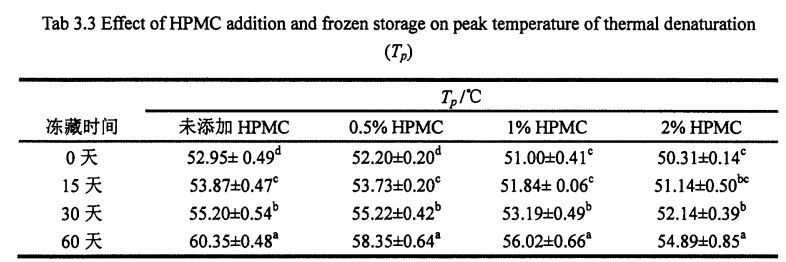
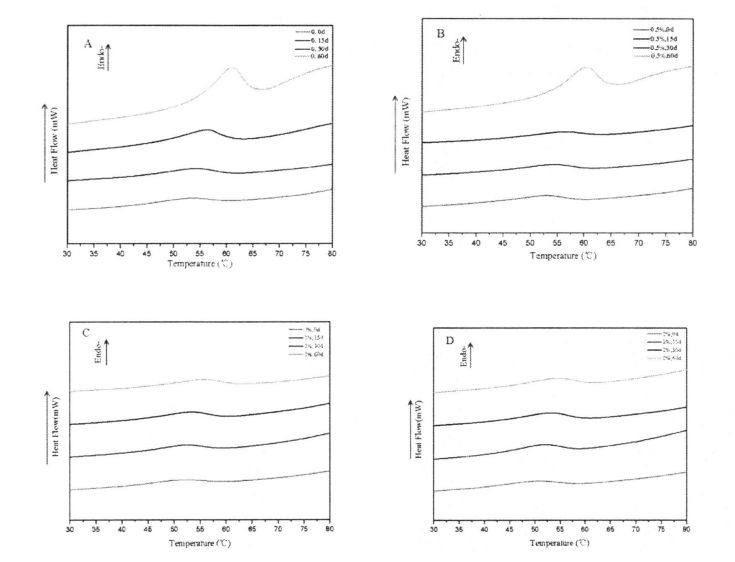
Fig 3.2 Typical DSC thermograms of gluten proteins with 0%HPMC(A);with O.5%HPMC(B); with 1%HPMC(C);with 2%HPMC(D)after different time of frozen storage,from 0d to 60d indicated from the lowest curve to the highest one in each graph. සටහන: A HPMC එකතු නොකර තිරිඟු ග්ලූටන් හි ඩීඑස්සී වක්රය යනු ය; B යනු 5% HPMC සමඟ තිරිඟු ග්ලූටන් හි O. DSC වක්රය එකතු කිරීමයි; C යනු තිරිඟු ග්ලූටන් 1% HPMC සමඟ ඩීඑස්සී වක්රය; D is the DSC curve of wheat gluten with 2% HPMC 3.3.3 Effects of HPMC addition amount and freezing time on free sulfhydryl content (C-SH) Intermolecular and intramolecular covalent bonds are very important for the stability of dough network structure. ඩිස්ෆයිඩ් බැඳුම්කරයක් (-SS-) යනු නිදහසට කරුණක් වන නිදහස් සල්ෆයිලද්රාල් කණ්ඩායම් දෙකක් (.ශ්. Glutenin is composed of glutenin and gliadin, the former can form intramolecular and intermolecular disulfide bonds, while the latter can only form intramolecular disulfide bonds [1241] Therefore, disulfide bonds are an intramolecular/intermolecular disulfide bond. හරස් සම්බන්ධ කිරීමේ වැදගත් ක්රමය. 0% එකතු කිරීම හා සසඳන විට, ඕ. කැටි කිරීමකින් තොරව 5% සහ සී-ෂෙක් කැටි කිරීමකින් තොරව 5% සහ 1% HPMC සහ ග්ලූටන්ගේ සී-ෂෙටියන් කැටි කිරීම පිළිවෙලින් පිළිවෙලින් වෙනස් වීමේ අංශක ප්රමාණයක් ඇත. විශේෂයෙන්, HPMC කිසිදු HPMC කිසිදු ග්ලූටන් සී. එස්. A1. (2012) දින 120 ක ශීත කළ ගබඩා කිරීමෙන් පසුව, නිදහස් ඇඟිලි සහිත කණ්ඩායම්වල අන්තර්ගතය සැලකිය යුතු ලෙස වැඩි වන බව සඳහන් වේ. දේශීයව කැටි කිරීමේ වේලාවක දේශීයව සෑදී ඇත [1161. වැන්ග්, ඒඑන්එස්.
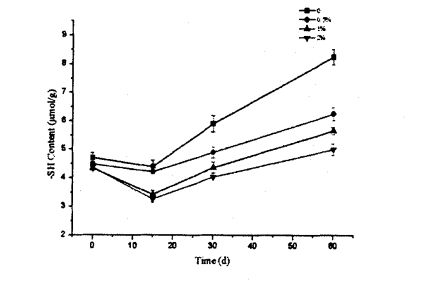
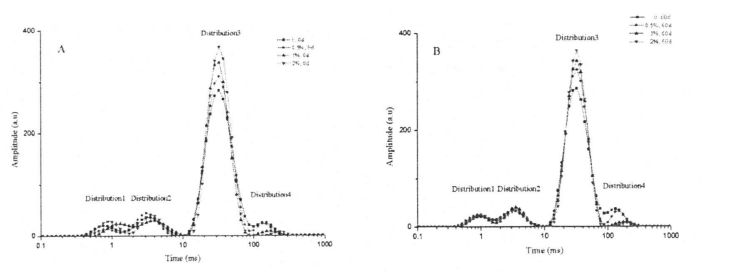
However, there were obvious differences in the height and area of T23 distribution of wet gluten mass that was not frozen and contained different HPMC additions, and with the increase of addition, the height and area of T23 distribution increased (Fig. 3.4). This change shows that HPMC can significantly increase the relative content of limited water, and it is positively correlated with the added amount within a certain range. In addition, with the extension of freezing storage time, the height and area of T23 distribution of the wet gluten mass with the same HPMC content decreased to varying degrees. Therefore, compared with bound water, limited water showed a certain effect on freezing storage. Sensitivity. මෙම ප්රවණතාවයෙන් ඇඟවෙන්නේ ග්ලූටන් ප්රෝටීන් අනුකෘතිය සහ සීමිත ජලය අතර අන්තර්ක්රියාකාරිත්වය දුර්වල වන බවයි. This may be because more hydrophobic groups are exposed during freezing, which is consistent with the thermal denaturation peak temperature measurements. විශේෂයෙන්, තෙත් ග්ලූටන් ස්කන්ධය සඳහා T23 GLUTEN ස්කන්ධය බෙදා හැරීමේ උස හා ප්රදේශය 2% HPMC එකතු කිරීම සැලකිය යුතු වෙනසක් පෙන්නුම් කළේ නැත. This indicates that HPMC can limit the migration and redistribution of water, and can inhibit the transformation of the water state from the restricted state to the free state during the freezing process.
In addition, the height and area of the T24 distribution of the wet gluten mass with different contents of HPMC were significantly different (Fig. 3.4, A), and the relative content of free water was negatively correlated with the amount of HPMC added. මෙය ඩැං බෙදාහැරීමේ ප්රතිවිරුද්ධ දෙයකි. Therefore, this variation rule indicates that HPMC has water holding capacity and converts free water to confined water. කෙසේ වෙතත්, දින 60 ක ශීත කිරීමේ උස හා භූමි ප්රමාණය, T24 බෙදාහැරීමේ උස හා ප්රදේශය වෙනස් වන්නේ අංශක ප්රමාණයට ය. This is mainly due to the change of the gluten protein conformation and the destruction of the "layer" unit in the gluten structure, which changes the state of the confined water contained in it. කෙසේ වෙතත්, ඩීඑස්සී හි කැටි නොවන ජලයේ අන්තර්ගතය ද, මැනිවෑරුම් ක්රම කාලය දීර් and කිරීම සමඟ වැඩිවේ වුවද, දෙගුණයේ මිනුම් ක්රමවල සහ සංත්මිකතා මූලධර්මවල වෙනස, කැටි නොවන ජලය සහ නිදහස් ජලය සම්පූර්ණයෙන්ම සමාන නොවේ. තෙත් ග්ලූටන් ස්කන්ධය 2% HPMC සමඟ, දින 60 ක කැටි ආචයනයකින් පසු, බෙදාහැරීම් හතරෙන් එකක් සැලකිය යුතු වෙනස්කම් පෙන්නුම් කළ අතර, එච්.පී.එම්.සී. සහ ස්ථාවර ද්රවශීලතාවය.
පොදුවේ ගත් කල, ප්රෝටීන්වල ද්විතීයික ව්යුහය වර්ග හතරකින් බෙදා ඇත, α- සර්පිලාකාර, β-contristed, β-corner සහ අහඹු කැරලි. The most important secondary bonds for the formation and stabilization of the spatial conformation of proteins are hydrogen bonds. එබැවින්, ප්රෝටීන් එටාටරය යනු හයිඩ්රජන් බැඳුම්කර බිඳීමේ හා අනුකූල වෙනස්කම්වල ක්රියාවලියකි.
Fourier transform infrared spectroscopy (FT-IR) has been widely used for high-throughput determination of the secondary structure of protein samples. The characteristic bands in the infrared spectrum of proteins mainly include, amide I band (1700.1600 cm-1), amide II band (1600.1500 cm-1) and amide III band (1350.1200 cm-1). Correspondingly, the amide I band the absorption peak originates from the stretching vibration of the carbonyl group (-C=O-.), the amide II band is mainly due to the bending vibration of the amino group (-NH-) [1271], and the amide III band is mainly due to the amino bending vibration and .CN-.Synchronous compound vibration in the same plane of bond stretching vibration, and has a high sensitivity to changes in protein secondary structure [128'1291. Although the above three characteristic bands are all characteristic infrared absorption peaks of proteins, the specific In other words, the absorption intensity of amide II band is lower, so the semi-quantitative accuracy of protein secondary structure is poor; while the peak absorption intensity of amide I band is higher, so many researchers analyze the secondary structure of protein by this band [ 1301, but the absorption peak of water and the amide I band are overlapped at about 1640 cm. 1 wavenumber (Overlapped), which in turn affects the accuracy of the results. Therefore, the interference of water limits the determination of the amide I band in protein secondary structure determination. මෙම අත්හදා බැලීමේදී, ජලයේ මැදිහත්වීමෙන් වැළකී සිටීම සඳහා, mandioud III බෑන්ඩ් විශ්ලේෂණය කිරීමෙන් ග්ලූටන් ප්රෝටීන්වල ද්විතීයික ව්යුහයන් හතරේ සාපේක්ෂ අන්තර්ගතය ලබා ගන්නා ලදී. Peak position (wavenumber interval) of

රූපය 3.5 යනු ග්ලූටන් ප්රෝටීන් හි ආයිත්තිග පැවතීම වන්නේ ග්ලූටන් ප්රෝටීන් සමූහයේ එච්.පී.එම්.සී. (2001) applied the second derivative to fit the deconvoluted peaks with similar peak shapes [1321]. In order to quantify the relative content changes of each secondary structure, Table 3.5 summarizes the relative percentage content of the four secondary structures of gluten protein with different freezing times and different HPMC additions (corresponding peak integral area/peak total area).
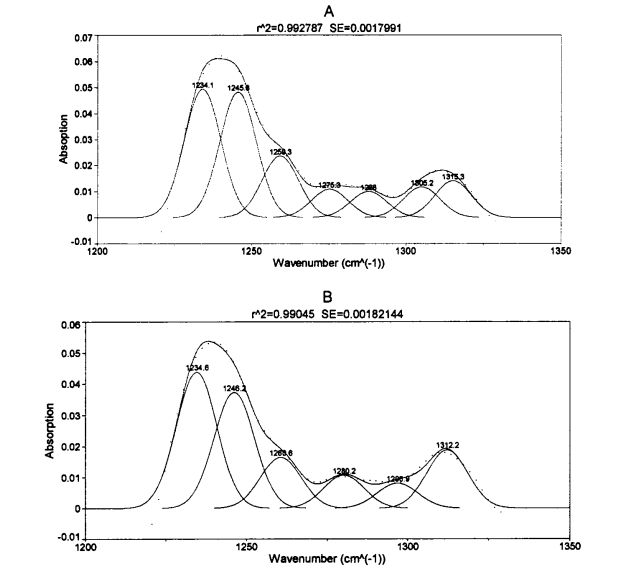
රූපය 3.5 ග්ලූටන් හි III වන ඇමයිඩ් බෑන්ඩ් ඕවූටන් හි ග්ලූටන් හි 0 D (අ), 2% HPMC 0 D (B)
Note: A is the infrared spectrum of wheat gluten protein without adding HPMC for 0 days of frozen storage; B යනු 2% HPMC සමඟ දින 0 ක් තිස්සේ ශීත කළ ආචයනයේ ප්රෝටීන් ප්රෝටීන් ප්රෝටීන් ප්රෝටීන් වේ
ශීත කළ ගබඩා කාලය දීර් and කිරීමත් සමඟ, HPMC හි විවිධ එකතු කිරීම් සහිත ග්ලූටන් ප්රෝටීන වල ද්විතීයික ව්යුහය විවිධ අංශවලට වෙනස් විය. It can be seen that both frozen storage and addition of HPMC have an effect on the secondary structure of gluten protein. HPMC එකතු කළ ප්රමාණය කුමක් වුවත්, ආ. නැමුණු ව්යුහය වඩාත් ආධිපත්යය දරන ව්යුහය වන 60% ක් පමණ වේ. After 60 days of frozen storage, add 0%, OB Gluten of 5% and 1% HPMC. The relative content of folds increased significantly by 3.66%, 1.87% and 1.16%, respectively, which was similar to the results determined by Meziani et al. (2011) [l33J]. කෙසේ වෙතත්, ග්ලූටන් සඳහා ශීත කළ ආචයනය 2% HPMC සමඟ අතිරේකව අතිරේකව සැලකිය යුතු වෙනසක් සිදු නොවීය. In addition, when frozen for 0 days, with the increase of HPMC addition, p. ගුණයක සාපේක්ෂ අන්තර්ගතය තරමක් වැඩි විය, විශේෂයෙන් එකතු කිරීමේ මුදල 2%, පි. නැමීම්වල සාපේක්ෂ අන්තර්ගතය 2.01% කින් වැඩි විය. D. නැමුණු ව්යුහය අන්තර් චලභයක් ලෙස බෙදිය හැකිය. නැමීම (ප්රෝටීන් අණු එකතුවක් ඇතිවීම නිසා ඇතිවේ), ප්රතිශක්ති නැවී සමාන්තර p. ප්රතිවිපාක තුනක් නැමුණු අතර, කැටි කිරීමේ ක්රියාවලිය අතරතුර කුමන ආදේශකද යන්න තීරණය කිරීම අපහසුය
changed. Some researchers believe that the increase in the relative content of the B-type structure will lead to an increase in the rigidity and hydrophobicity of the steric conformation [41], and other researchers believe that p. The increase in folded structure is due to part of the new β-Fold formation is accompanied by a weakening of the structural strength maintained by hydrogen bonding [421]. β- The increase in the folded structure indicates that the protein is polymerized through hydrophobic bonds, which is consistent with the results of the peak temperature of thermal denaturation measured by DSC and the distribution of transverse relaxation time measured by low-field nuclear magnetic resonance. Protein denaturation. අනෙක් අතට, 0.5%, 1% සහ 2% HPMC ග්ලූටන් ප්රෝටීන් α-සුළි සුළඟ. The relative content of helix increased by 0.95%, 4.42% and 2.03% respectively with the prolongation of freezing time, which is consistent with Wang, et a1. (2014) found similar results [134]. 0 of gluten without added HPMC. There was no significant change in the relative content of helix during the frozen storage process, but with the increase of the addition amount of freeze for 0 days. There were significant differences in the relative content of α-whirling structures.
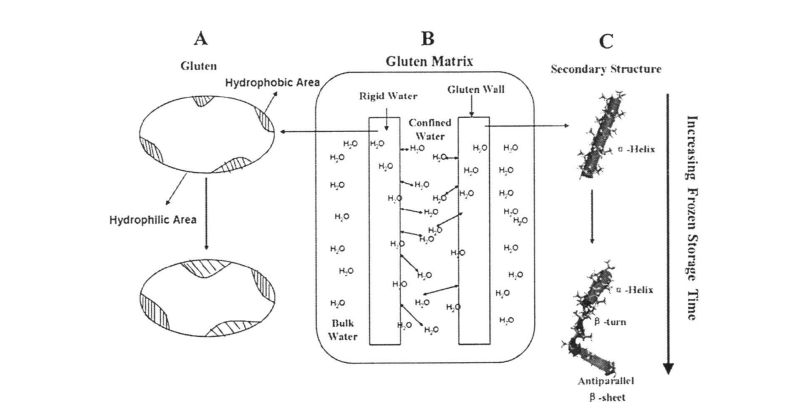
FIG 3.6 හයිඩ්රොෆොෆොබික් චාරිකා නිරාවරණය (අ), ජලය නැවත බෙදාහැරීම (ආ), ද්විතීයික ව්යුහාත්මක වෙනස්කම්, සහ ද්විතීයික ව්යුහාත්මක වෙනස්කම් (ඇ) වැඩිවන ශීත කළ ගබඩා කාලය සමඟ ග්ලූටන් අනුකෘතිය (ඇ)
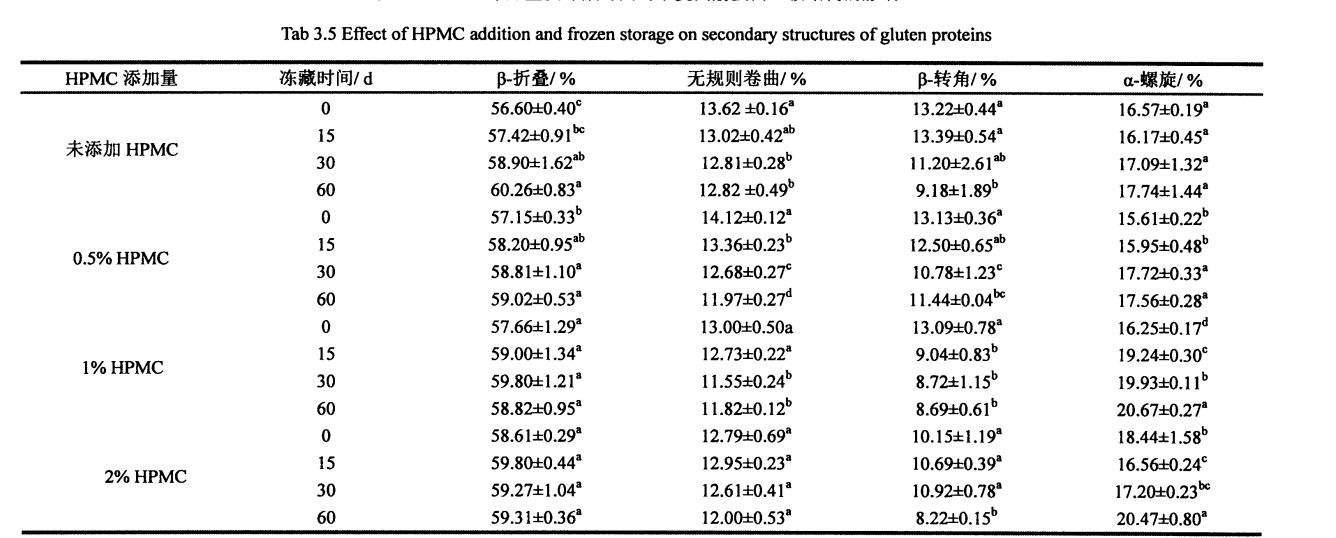
All samples with the extension of freezing time, p. The relative contents of the corners were significantly reduced. This shows that β-turn is very sensitive to freezing treatment [135. 1361], and whether HPMC is added or not has no effect. බුනර්, සහ ඒ 1. (2005) proposed that the β-chain turn of gluten protein is related to the β-turn space domain structure of the glutenin polypeptide chain [l 37]. Except that the relative content of random coil structure of gluten protein added with 2% HPMC had no significant change in frozen storage, the other samples were significantly reduced, which may be caused by the extrusion of ice crystals. In addition, when frozen for 0 days, the relative contents of α-helix, β-sheet and β-turn structure of gluten protein added with 2% HPMC were significantly different from those of gluten protein without HPMC. This may indicate that there is an interaction between HPMC and gluten protein, forming new hydrogen bonds and then affecting the conformation of the protein; or HPMC absorbs the water in the pore cavity of the protein space structure, which deforms the protein and leads to more changes between the subunits. close. The increase of the relative content of β-sheet structure and the decrease of the relative content of β-turn and α-helix structure are consistent with the above speculation. During the freezing process, the diffusion and migration of water and the formation of ice crystals destroy the hydrogen bonds that maintain the conformational stability and expose the hydrophobic groups of proteins. In addition, from the perspective of energy, the smaller the energy of the protein, the more stable it is. At low temperature, the self-organization behavior (folding and unfolding) of protein molecules proceeds spontaneously and leads to conformational changes.
ප්රෝටීන් අණු අතර හයිඩ්රොෆිලික් සහ හයිඩ්රොෆොබික් කණ්ඩායම් ඇතුළත් වේ. සාමාන්යයෙන්, ප්රෝටීන් මතුපිට හයිඩ්රොෆිලික් කණ්ඩායම් වලින් සමන්විත වන අතර, හයිඩ්රොෆිලික් කාණ්ඩ වලින් ජලය බැඳීම සහ සෛල තට්ටුවක් හරහා ප්රෝටීන් අණු අගුලු දැමීම වැළැක්වීම සහ ඒවායේ අනුකූල ස්ථාවරත්වය පවත්වා ගැනීම සඳහා ය. The interior of the protein contains more hydrophobic groups to form and maintain the secondary and tertiary structure of the protein through the hydrophobic force. Denaturation of proteins is often accompanied by exposure of hydrophobic groups and increased surface hydrophobicity.

3.3.7 HPMC අතිරේක ප්රමාණය සහ ග්ලූටන් හි ක්ෂුද්ර ජාල ව්යුහය මත ඇති වන අතිරේක ප්රමාණය සහ ගබඩා කාලය
The continuous gluten network structure contains many pores to maintain the carbon dioxide gas produced by the yeast during the proofing process of the dough. එබැවින්, ග්ලූටන් ජාල ව්යුහයේ ශක්තිය හා ස්ථාවරත්වය නිශ්චිත පරිමාව, ගුණාත්මකභාවය වැනි අවසාන නිෂ්පාදනයේ ගුණාත්මකභාවය සහ ව්යුහය හා සංවේදක තක්සේරු කිරීම වැනි අවසාන නිෂ්පාදනයේ ගුණාත්මක භාවයට ඉතා වැදගත් වේ. From a microscopic point of view, the surface morphology of the material can be observed by scanning electron microscopy, which provides a practical basis for the change of the gluten network structure during the freezing process.
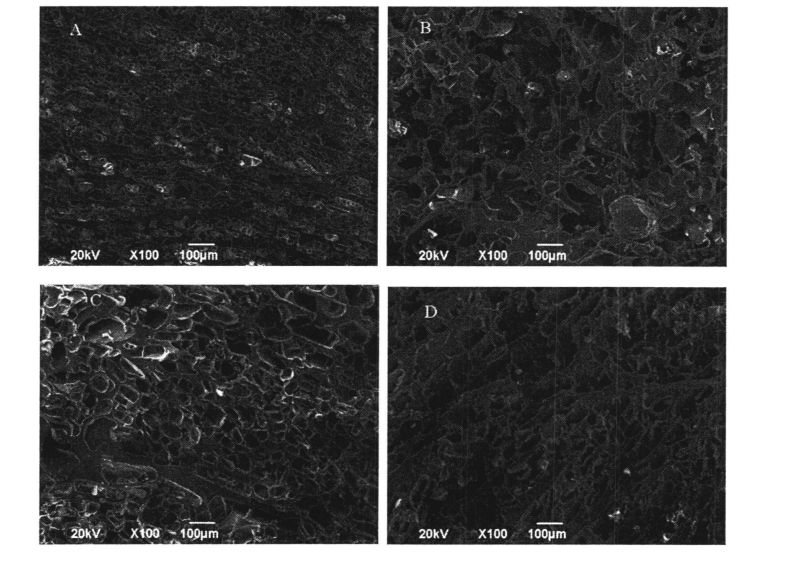
Small approximate porous sponge-like morphology. However, after 60 days of frozen storage, the cells in the gluten microstructure without HPMC became larger in size, irregular in shape, and unevenly distributed (Fig. 3.7, A, B), mainly due to the This is caused by the fracture of the "wall", which is consistent with the measurement results of the free thiol group content, that is, during the freezing process, the ice crystal squeezes and breaks the disulfide ව්යුහයේ ශක්තිය හා අඛණ්ඩතාවයට බලපාන බැඳුම්කරය. As reported by Kontogiorgos & Goff (2006) and Kontogiorgos (2007), the interstitial regions of the gluten network are squeezed due to freeze-shrinkage, resulting in structural disruption [138. 1391]. In addition, due to dehydration and condensation, a relatively dense fibrous structure was produced in the spongy structure, which may be the reason for the decrease in free thiol content after 15 days of frozen storage, because more disulfide bonds were generated and frozen storage. The gluten structure was not severely damaged for a shorter time, which is consistent with Wang, et a1. (2014) observed similar phenomena [134]. At the same time, the destruction of the gluten microstructure leads to freer water migration and redistribution, which is consistent with the results of low-field time-domain nuclear magnetic resonance (TD-NMR) measurements. Some studies [140, 105] reported that after several freeze-thaw cycles, the gelatinization of rice starch and the structural strength of the dough became weaker, and the water mobility became higher. Nonetheless, after 60 days of frozen storage, the microstructure of gluten with 2% HPMC addition changed less, with smaller cells and more regular shapes than gluten without HPMC addition (Fig. 3.7, B, D). This further indicates that HPMC can effectively inhibit the destruction of gluten structure by recrystallization.
3.4 පරිච්ඡේදයේ සාරාංශය
මෙම අත්හදා බැලීම තෙත් ග්ලූටන් පිටි ගුලිය සහ ග්ලූටන් ප්රෝටීන් විසින් විවිධ අන්තර්ගතයන් (0, 0.5% සහ 2%) එකතු කිරීමෙන් (0, 0%% සහ 2%) කැටි ආචයනය තුළ (0, 0%, 1% සහ 2%) එකතු කිරීම (0, 0%, 1% සහ 2%). properties, thermodynamic properties, and effects of physicochemical properties. ශීත ස් st ටිකවල කැටි කිරීමේ ක්රියාවලියේදී ජල තත්වය වෙනස් කිරීම හා නැවත බෙදාහැරීම සැලකිය යුතු ලෙස වැඩි කළ අතර, ග්ලූටන් ව්යුහයේ කැටි ජල අන්තර්ගතය සැලකිය යුතු ලෙස වැඩි කළ අතර, අවසානයේදී ඇනූ වල සැකසුම් ගුණාංග වෙනස් වීමට හේතු විය. Deterioration of product quality. සංඛ්යාත පරිලෝකනය කිරීමේ ප්රති results ලවලින් පෙනී යන්නේ HPMC එකතු නොකර තෙත් ග්ලූටන් ස්කන්ධයේ ප්රත්යාස්ථ මාපාංකය සහ දුස්ස්රාවී මායාව සැලකිය යුතු ලෙස අඩුවී ඇති අතර පරිලෝකනය ඉලෙක්ට්රෝන අන්වීක්ෂය සැලකිය යුතු ලෙස අඩුවී ඇති අතර පරිලෝකන ඉලෙක්ට්රෝනය එහි ක්ෂුද්ර ව්යුහයට හානි වූ බව පෙන්නුම් කළේය. නොමිලේ සල්ෆෙයිත්රිල් සමූහයේ අන්තර්ගතය සැලකිය යුතු ලෙස වැඩි කළ අතර, එහි හයිඩ්රොෆොබික් කණ්ඩායම වඩාත් නිරාවරණය වූ අතර, එය ග්ලූටන් ප්රෝටීන ප්රෝටීන්හි තාප අල්මාරිතා උෂ්ණත්වය හා මතුපිට ජල උන්නතාංශය සැලකිය යුතු ලෙස වැඩි කළේය. However, the experimental results show that the addition of I-IPMC can effectively inhibit the changes in the structure and properties of wet gluten mass and gluten protein during freezing storage, and within a certain range, this inhibitory effect is positively correlated with the addition of HPMC. This is because HPMC can reduce the mobility of water and limit the increase of the freezable water content, thereby inhibiting the recrystallization phenomenon and keeping the gluten network structure and the spatial conformation of the protein relatively stable. මෙයින් පෙනී යන්නේ HPMC එකතු කිරීම ශීත කළ ඇනූ ව්යුහයේ අඛණ්ඩතාව effectively ලදායී ලෙස පවත්වා ගත හැකි බවයි. එමඟින් නිෂ්පාදනවල ගුණාත්මකභාවය සහතික කරයි.
ශීත කළ ආචයනය යටතේ පිෂ් ch යේ ව්යුහයේ ව්යුහයේ ව්යුහය හා ගුණාංග මත 4 වන පරිච්ඡේදය බලපෑම්
Starch is a chain polysaccharide with glucose as the monomer. key) two types. From a microscopic point of view, starch is usually granular, and the particle size of wheat starch is mainly distributed in two ranges of 2-10 pro (B starch) and 25-35 pm (A starch). From the perspective of crystal structure, starch granules include crystalline regions and amorphous regions (je, non-crystalline regions), and the crystal forms are further divided into A, B, and C types (it becomes V-type after complete gelatinization). Generally, the crystalline region consists of amylopectin and the amorphous region consists mainly of amylose. This is because, in addition to the C chain (main chain), amylopectin also has side chains composed of B (Branch Chain) and C (Carbon Chain) chains, which makes amylopectin appear "tree-like" in raw starch. ස් stal ටිකයක් සෑදීම සඳහා ස් cry ටිකරූපී මිටියේ හැඩය එක්තරා ආකාරයකින් සකසා ඇත.
Starch is one of the main components of flour, and its content is as high as about 75% (dry basis). At the same time, as a carbohydrate widely present in grains, starch is also the main energy source material in food. In the dough system, starch is mostly distributed and attached to the network structure of gluten protein. සැකසුම් හා ගබඩා කිරීමේදී, ස්ටාර්චර්ස් බොහෝ විට ජෙලටින්කරණය හා වයස්ගත අවධියන්ට මුහුණ දෙයි.
Among them, starch gelatinization refers to the process in which starch granules are gradually disintegrated and hydrated in a system with high water content and under heating conditions. එය දළ වශයෙන් ප්රධාන ක්රියාදාමයන් තුනකට බෙදිය හැකිය. 1) Reversible water absorption stage; before reaching the initial temperature of gelatinization, the starch granules in the starch suspension (Slurry) keep their unique structure unchanged, and the external shape and internal structure basically do not change. Only very little soluble starch is dispersed in the water and can be restored to its original state. 2) ආපසු හැරවිය නොහැකි ජල අවශෝෂණ අවධිය; උෂ්ණත්වය වැඩිවන විට, ජලය පිෂ් chty ස්කාරයිට් මිටි අතර පරතරය ඉක්මවා යයි, ආපසු හැරවිය නොහැකි ලෙස පිෂ් ch ය ගසාගෙන යන අතර පරිමාව කිහිප වතාවක්ම අවශෝෂණය කර ගන්නා අතර, පිෂ් ch යේ අණු අතර හයිඩ්රජන් බන්ධනය කැඩී යයි. එය දිගු කර ස් st ටික අතුරුදහන් වේ. At the same time, the birefringence phenomenon of starch, that is, the Maltese Cross observed under a polarizing microscope, begins to disappear, and the temperature at this time is called the initial gelatinization temperature of starch. 3) Starch granule disintegration stage; starch molecules completely enter the solution system to form starch paste (Paste/Starch Gel), at this time the viscosity of the system is the largest, and the birefringence phenomenon completely disappears, and the temperature at this time is called the complete starch gelatinization temperature, the gelatinized starch is also called α-starch [141]. ඇනූ පිසින විට, පිෂ් ch යේ ජෙලටෙට කිරීම ආහාර එහි අද්විතීය වයනය, රසය, රසය, වර්ණය සහ සැකසුම් ලක්ෂණ වලින් ආහාර ලබා ගනී.
Many studies have shown that the gel strength of starch paste decreases, it is easy to age, and its quality deteriorates under the condition of freezing storage, such as Canet, et a1. (2005) studied the effect of freezing temperature on the quality of potato starch puree; Ferrero, et a1. (1993) තිරිඟු සහ ඉරිඟු පිෂ් ch ය පේස්ට් වල ගුණාංග මත කැටි කිරීමේ වේගය සහ විවිධ වර්ගයේ ආකලනවල බලපෑම [151-156] විමර්ශනය කළේය [151-156]. කෙසේ වෙතත්, පිෂ් chan ය කැටිති (ස්වදේශීය පිෂ් ch ය) වල ව්යුහය හා ගුණාංග මත ශීත කළ ආචයනයේ බලපෑම පිළිබඳ ප්රතිචක්රීකරණයේ බලපෑම තවදුරටත් ගවේෂණය කළ යුතුය. Frozen dough (excluding pre-cooked frozen dough) is in the form of ungelatinized granules under the condition of frozen storage. Therefore, studying the structure and structural changes of native starch by adding HPMC has a certain effect on improving the processing properties of frozen dough. වැදගත්කම.
මෙම අත්හදා බැලීමේදී, විවිධ HPMC අන්තර්ගතය (0, 0.5%, 1%, 2%) එකතු කිරීමෙන්, එක්තරා කැටි කාල පරිච්ඡේදයක් තුළ HPMC ප්රමාණය (0, 15, 30, 30, 60) අධ්යයනය කරන ලදී. on starch structure and its gelatinization influence of nature.
4.2 පර්යේෂණාත්මක ද්රව්ය හා ක්රම
උපකරණ නාමය
HH ඩිජිටල් නියත උෂ්ණත්වය ජල ස්නානය
BC / BD-27s 27cc ශීතකරණයක්
Dhg. 9070A Blast Drying Oven
ඩිස්කවරි ආර් 3 භ්රමණ රයෝමීටරය
නිෂ්පාදකයා
Weigh 1 g of starch, add 9 mL of distilled water, fully shake and mix to prepare a 10% (w/w) starch suspension. ඉන්පසු නියැදි විසඳුම තබන්න. 18 ℃ refrigerator, frozen storage for 0, 15 d, 30 d, 60 d, of which 0 day is the fresh control. Add 0.5%, 1%, 2% (w/w) HPMC instead of the corresponding quality starch to prepare samples with different addition amounts, and the rest of the treatment methods remain unchanged.
In this experiment, a rheometer was used instead of a fast viscometer to measure the gelatinization characteristics of starch. See Bae et a1. (2014) ක්රමවේදය [1571] සුළු වෙනස් කිරීම් සමඟ. The specific program parameters are set as follows: use a plate with a diameter of 40 mill, the gap (gap) is 1000 mm, and the rotation speed is 5 rad/s; I) incubate at 50 °C for 1 min; ii) at 5. C/min heated to 95°C; iii) kept at 95°C for 2.5 min, iv) then cooled to 50°C at 5°C/min; v) අවසාන වශයෙන් මිනිත්තු 5 ක් සඳහා 50 ° C දී පැවැත්වේ.
Draw 1.5 mL of sample solution and add it to the center of the rheometer sample stage, measure the gelatinization properties of the sample according to the above program parameters, and obtain the time (min) as the abscissa, the viscosity (Pa s) and the temperature (°C) as the starch gelatinization curve of the ordinate. According to GB/T 14490.2008 [158], the corresponding gelatinization characteristic indicators—gelatinization peak viscosity (field), peak temperature (Ang), minimum viscosity (high), final viscosity (ratio) and decay value (Breakdown) are obtained. වටිනාකම, BV) සහ පුනර්ජනන අගය (සෙවීමේ වටිනාකම, SV), එහිදී, දිරාපත් වූ අගය = පීක් දුස්ස්රාවිතතාවය - අවම දුස්ස්රාවිතතාවය; සෙට්බැක් අගය = අවසාන දුස්ස්රාවිතතාවය - අවම දුස්ස්රාවිතතාවය. සෑම නියැදියක්ම තුන් වරක් පුනරාවර්තනය විය.
ඇම්ලයිට් ග්රෑම් 2.5 ක් ගෙන පිෂ් ch ය කිරි සෑදීම සඳහා 1: 2 අනුපාතයකින් ආසවනය කළ ජලය සමඟ මිශ්ර කරන්න. Freeze at 18°C for 15 d, 30 d, and 60 d. Add 0.5, 1, 2% HPMC (w/w) to replace starch of the same quality, and other preparation methods remain unchanged. කැටි කිරීමේ ප්රතිකාර අවසන් වූ පසු, එය ඉවතට ගන්න, පැය 4 ක් සඳහා 4 ° C.
Take 1.5 mL of sample solution and place it on the sample stage of the rheometer (Discovery.R3), press down the 40 m/n plate with a diameter of 1500 mm, and remove the excess sample solution, and continue to lower the plate to 1000 mm, on motor, the speed was set to 5 rad/s and rotated for 1 min to fully homogenize the sample solution and avoid the sedimentation of starch granules. උෂ්ණත්ව පරිලෝකනය 25 ° C ට ආරම්භ වී 5 ට අවසන් වේ. සී / මයි ප්රමාණය 95 ° C දක්වා ඔසවා තැබූ අතර මිනිත්තු 2 ක් තබා ඇති අතර පසුව 5 ° C 5 ට මිනිත්තු 25 ක් දක්වා අඩු කළේය.
ඉන්පසු, දෝලනය සංඛ්යාතය අතුගාන්න, වික්රියා මුදල (වික්රියා) දක්වා (වික්රියා) 0.1% දක්වා සකසන්න (වික්රියා ස්වීප් ප්රති results ල අනුව) සංඛ්යාත පරාසය O. 1 සිට 10 දක්වා. Each sample was repeated three times.
ඊට අනුරූප කැටි කිරීමේ ප්රතිකාර කාලය පසු, සාම්පල පිටතට ගෙන, සම්පූර්ණ දියුණුවක් ලබාගෙන පැය 48 ක් සඳහා 40 ° C දී උඳුනක වියළා විය. Finally, it was ground through a 100-mesh sieve to obtain a solid powder sample for use (suitable for XRD testing). See Xie, et a1. (2014) method for sample preparation and determination of thermodynamic properties '1611, weigh 10 mg of starch sample into a liquid aluminum crucible with an ultra-micro analytical balance, add 20 mg of distilled water in a ratio of 1:2, press and seal it and place it at 4 °C In the refrigerator, equilibrated for 24 h. Freeze at 18°C (0, 15, 30 and 60 days). Add 0.5%, 1%, 2% (w/w) HPMC to replace the corresponding quality of starch, and other preparation methods remain unchanged. After the freezing storage time is over, take out the crucible and equilibrate at 4 °C for 4 h.
දියවන ලද ශීත පිෂ් st ෂ් ch ය පැය 48 ක් සඳහා උඳුනක උඳුනක වියළී ගොස් පැය 48 ක් සඳහා උඳුනක වියළා, පසුව පිෂ් chan යේ කුඩු සාම්පල ලබා ගැනීම සඳහා දැලක් 100 ක් හරහා වෙඩි තබා ඇත. Take a certain amount of the above samples, use D/MAX 2500V type X. The crystal form and relative crystallinity were determined by X-ray diffractometer. The experimental parameters are voltage 40 KV, current 40 mA, using Cu. X. රේ ප්රභවය ලෙස කේ.එස්. At room temperature, the scanning angle range is 30--400, and the scanning rate is 20/min. සාපේක්ෂ ස් stal ටිකරූපීතාව (%) = ස් st ටිකරූපී උපරිම ප්රදේශය / මුළු භූමි ප්රමාණය x 100%, මුළු ප්රදේශයම පසුබිම් ස්ථානයේ එකතුව සහ උපරිම අනිවාර්ය ප්රදේශය [1 62].
Take 0.1 g of the dried, ground and sieved amyloid into a 50 mL centrifuge tube, add 10 mL of distilled water to it, shake it well, let it stand for 0.5 h, and then place it in a 95°C water bath at a constant temperature. After 30 min, after gelatinization is complete, take out the centrifuge tube and place it in an ice bath for 10 min for rapid cooling. අවසාන වශයෙන්, කේන්ද්රාපසාරී 5000 සිට මිනිත්තු 20 ක් RPM, සහ ප්රපාතයක් ලබා ගැනීම සඳහා අතිරික්ත අයව වත් කරන්න. Swelling Power=precipitation mass/sample mass [163].
4.3 විශ්ලේෂණය සහ සාකච්ඡාව

The starch suspension with a certain concentration is heated at a certain heating rate to make the starch gelatinized. After starting to gelatinize, the turbid liquid gradually becomes pasty due to the expansion of starch, and the viscosity increases continuously. පසුව පිෂ් ch ය කැටිති කැඩී යාම සහ දුස්ස්රාවිතතාවය අඩු වේ. When the paste is cooled at a certain cooling rate, the paste will gel, and the viscosity value will further increase. The viscosity value when it is cooled to 50 °C is the final viscosity value (Figure 4.1).
Table 4.2 lists the influence of several important indicators of starch gelatinization characteristics, including gelatinization peak viscosity, minimum viscosity, final viscosity, decay value and appreciation value, and reflects the effect of HPMC addition and freezing time on starch paste. රසායනික ගුණ වල බලපෑම්. පර්යේෂණාත්මක ප්රති results ලවලින් පෙනී යන්නේ උපරිම දෘෂ්ටි කෝණයන්, අවම දුකකම සහ පිෂ් ch යකින් තොරව පිෂ් ch යකගේ සංක්ෂිප්තතාවයේ අවසාන දුස්ස්රාවිතතාවයයි. එච්.පී.එම්.සී. Specifically, the peak viscosity gradually increased from 727.66+90.70 CP (without adding HPMC) to 758.51+48.12 CP (adding 0.5% HPMC), 809.754-56.59 CP (adding 1 %HPMC), and 946.64+9.63 CP (adding 2% HPMC); the minimum viscosity was increased from 391.02+18.97 CP (blank not adding) to 454.95+36.90 (adding O .5% HPMC), 485.56+54.0.5 (add 1% HPMC) and 553.03+55.57 CP (add 2% HPMC); අවසාන දුස්ස්රාවිතතාවය 794.62.4.6.4.4.4.4.4.8 cp 882.24 ± 22.40 සීපී (0.5% HPMC එකතු කිරීම) සහ 910.884-34.57 සීපී (2% HPMC එකතු කිරීම); කෙසේ වෙතත්, අත්තනෝමතික වටිනාකම 336.644-71.73 සීපී (HPMC එකතු නොකර 0.5% HPMC), 324.19 ± 2.54 cp (එකතු කරන්න
අනෙක් අතට, එච්පීඑම්සී එකතු කරන ලද ප්රමාණයට සමාන වූ විට, පිඟන් කෝණ කාලය දීර් for ය ව්යාප්ත කිරීමත් සමඟ උපරිම දුස්ස්රාවිතතාවය, අවම දුස්පය, අවසාන දුසිම්කම, දිරායාම, දිරාපත්වීමේ වටිනාකම සැලකිය යුතු ලෙස වැඩි විය. STPMC එකතු නොකර පිෂ් ch ය අත්හිටුවීමේ උපරිම දුස්ස්රාවිතතාවය 727.66 ± 90.70.70 cp (දින 0 ක් සඳහා ශීත කළ ආචයනය) සිට 1584.44 + 68.11 සීපී (දින 60 ක් සඳහා ශීත කළ ආචයනය); adding 0.5 The peak viscosity of starch suspension with %HPMC increased from 758.514-48.12 CP (freezing for 0 days) to 1415.834-45.77 CP (freezing for 60 days); starch suspension with 1% HPMC added The peak viscosity of the starch liquid increased from 809.754-56.59 CP (freeze storage for 0 days) to 1298.19-±78.13 CP (frozen storage for 60 days); while the starch suspension with 2% HPMC CP added Gelatinization peak viscosity from 946.64 ± 9.63 CP (0 days frozen) increased to 1240.224-94.06 CP (60 days frozen). At the same time, the lowest viscosity of starch suspension without HPMC was increased from 391.02-41 8.97 CP (freezing for 0 days) to 556.77±29.39 CP (freezing for 60 days); adding 0.5 The minimum viscosity of the starch suspension with %HPMC increased from 454.954-36.90 CP (freezing for 0 days) to 581.934-72.22 CP (freezing for 60 days); the starch suspension with 1% HPMC added The minimum viscosity of the liquid increased from 485.564-54.05 CP (freezing for 0 days) to 625.484-67.17 CP (freezing for 60 days); while the starch suspension added 2% HPMC CP gelatinized The lowest viscosity increased from 553.034-55.57 CP (0 days frozen) to 682.58 ± 20.29 CP (60 days frozen).

(Frozen storage for 0 days) increased to 1198.09 ± 41.15 CP (frozen storage for 60 days). Correspondingly, the attenuation value of starch suspension without adding HPMC increased from 336.64 ± 71.73 CP (frozen storage for 0 days) to 1027.67 ± 38.72 CP (frozen storage for 60 days); adding 0.5 The attenuation value of starch suspension with %HPMC increased from 303.56±11.22 CP (frozen storage for 0 days) to 833.9±26.45 CP (frozen storage for 60 days); starch suspension with 1% HPMC added The attenuation value of the liquid was increased from 324.19 ± 2.54 CP (freezing for 0 days) to 672.71 ± 10.96 CP (freezing for 60 days); 2% HPMC එකතු කරන අතර, පිෂ් ch ය අත්හිටුවීමේ අත්තනෝමතික වටිනාකම 393.61 ± 45.94 cp සිට 557.64 ± 73.77 CP දක්වා (දින 60 ක් කැටි කිරීම); while the starch suspension without HPMC added The retrogradation value increased from 403.60 ± 6.13 C
P (දින 0 ක් සඳහා ශීත කළ ආචයනය) සිට 856.38 ± 16 ± 10 CP (දින 60 ක් තිස්සේ ශීත කළ ආචයනය); the retrogradation value of starch suspension added with 0.5% HPMC increased from 427 .29±14.50 CP (frozen storage for 0 days) increased to 740.93±35.99 CP (frozen storage for 60 days); the retrogradation value of starch suspension added with 1% HPMC increased from 360.48±41. 39 CP (frozen storage for 0 days) increased to 666.46 ± 21.40 CP (frozen storage for 60 days); while the retrogradation value of starch suspension added with 2% HPMC increased from 357.85 ± 21.00 CP (frozen storage for 60 days). දින 0) 515.51 ± 20.86 cp (දින 60 ක් ශීත කළ) දක්වා වැඩි විය.
කැටි ගබඩා කාලය දීර් and කිරීමත් සමඟ, පිෂ් ch ය ජෙලටින්කරණ ලක්ෂණ දර්ශක දර්ශකය වැඩි වූ අතර එය තාඕ ET A1 ට අනුකූල වේ. එෆ් 2015) This is mainly because in the process of freezing storage, the amorphous region (Amorphous Region) of starch granules is destroyed by ice crystallization, so that the amylose (the main component) in the amorphous region (non-crystalline region) undergoes phase separation (Phase. separated) phenomenon, and dispersed in the starch suspension, resulting in an increase in the viscosity of starch ජෙලටින්කරණය සහ අදාළ අත්තනෝමතික වටිනාකම සහ පසුගාමී වටිනාකම වැඩිවීම. කෙසේ වෙතත්, පිෂ් ch ය ව්යුහයේ අයිස් ස් st ටිකීකරණයේ බලපෑම HPMC එකතු කිරීම තහනම් කළේය. Therefore, the peak viscosity, minimum viscosity, final viscosity, decay value and retrogradation rate of starch gelatinization increased with the addition of HPMC during frozen storage. අනුපිළිවෙලින් වැඩි කිරීම සහ අඩු කිරීම.

The effect of shear rate on the apparent viscosity (shear viscosity) of the fluid was investigated by the Steady Flow Test, and the material structure and properties of the fluid were reflected accordingly. 4.3 හි වගුව 4.3, නොගැලපෙන ගැළපීම, අනුකූලතා සංග්රහ කේ සහ ප්රවාහ ලක්ෂ්ය දර්ශකයේ, මෙන්ම ඉහත පරාමිතීන් පිළිබඳ HPMC හි අතිරික්ත ප්රමාණයේ කැටි ගබඩා කාලය K ගේට්ටුව.


It can be seen from Table 4.3 that all the flow characteristic indices, 2, are less than 1. Therefore, starch paste (whether HPMC is added or whether it is frozen or not) belongs to Pseudoplastic Fluid, and all show shearing Thinning phenomenon (as the shear rate increases, the shear viscosity of the fluid decreases). In addition, the shear rate scans ranged from 0.1 s, respectively. 1 increased to 100 s ~, and then decreased from 100 sd to O. The rheological curves obtained at 1 sd do not completely overlap, and the fitting results of K, s are also different, so the starch paste is a thixotropic pseudoplastic fluid (whether HPMC is added or whether it is frozen or not). කෙසේ වෙතත්, එකම කැටි ගබඩා කාලය යටතේ, HPMC එකතු කිරීම වැඩිවීමත් සමඟ, ස්කෑන් දෙකේ කේ එන් අගයවල මිල ගණන් ක්රමයෙන් අඩු වන අතර එයින් HPMC එකතු කිරීම ෂියර් ආතතිය යටතේ පිෂ් ch ය පේස්ට් එකක ව්යුහය ඇති කරයි. එය ක්රියාව යටතේ සාපේක්ෂව ස්ථාවර මට්ටමක පවතින අතර "තෙක්ට්ට්රොපික් මුද්ද" අඩු කරයි
(Thixotropic Loop) area, which is similar to Temsiripong, et a1. (2005) එම නිගමනයම වාර්තා කළේ [167]. This may be mainly because HPMC can form intermolecular cross-links with gelatinized starch chains (mainly amylose chains), which "bound" the separation of amylose and amylopectin under the action of shearing force. , so as to maintain the relative stability and uniformity of the structure (Figure 4.2, the curve with shear rate as abscissa and shear stress as ordinate).
On the other hand, for the starch without frozen storage, its K value decreased significantly with the addition of HPMC, from 78.240±1.661 Pa ·sn (without adding HPMC) to 65.240±1.661 Pa ·sn (without adding HPMC), respectively. 683±1.035 Pa ·sn (add 0.5% Hand MC), 43.122±1.047 Pa ·sn (add 1% HPMC), and 13.926±0.330Pa·Sn (add 2% HPMC), while the n value increased significantly, from 0.277 ± 0.011 (without adding HPMC) to 0.277 ± 0.011 in turn. 310 ± 0.009 (add 0.5% HPMC), O. 323 ± 0.013 (add 1% HPMC) and O. 43 1 ± 0.0 1 3 (adding 2% HPMC), which is similar to the experimental results of Techawipharat, Suphantharika, & BeMiller (2008) and Turabi, Sumnu, & Sahin (2008), and the increase of n value shows that the HPMC එකතු කිරීම තරලය ව්යාජදෝපොස්ටික් සිට නිව්ටෝනියානු [168'1691] දක්වා වෙනස් වීමේ ප්රවණතාවක් ඇති කරයි. at the same time, For the starch stored frozen for 60 days, the K, n values showed the same change rule with the increase of HPMC addition.
However, with the prolongation of freezing storage time, the values of K and n increased to different degrees, among which the value of K increased from 78.240 ± 1.661 Pa·sn (unadded, 0 days) to 95.570 ± 1, respectively. 2.421 Pa·sn (no addition, 60 days), increased from 65.683±1.035 Pa ·S n (addition of O. 5% HPMC, 0 days) to 51.384±1.350 Pa ·S n (Add to 0.5% HPMC, 60 days), increased from 43.122±1.047 Pa ·sn (adding 1% HPMC, 0 days) to 56.538±1.378 Pa ·sn (adding 1% HPMC, 60 days) ), and increased from 13.926 ± 0.330 Pa ·sn (adding 2% HPMC, 0 days) to 16.064 ± 0.465 Pa ·sn (adding 2% HPMC, 60 days); 0.277 ± 0.011 (hpmc, දින 0) සිට 334 ± 0.014 (0.5% HPMC එකතු කරන ලදි), 0.323 ± 0.013 දක්වා (0.323 ± 0.013 (HPMC, දින 0) සිට 0.340 දක්වා වැඩි විය 0.013 (1% HPMC, දින 60) සහ 0.431 ± 0.013 (1% HPMC, දින 60) 0.404 + 0.020 දක්වා (0.404 + 0.020 දක්වා (2% HPMC, දින 60 ක් එක් කරන්න). සාපේක්ෂව, HPMC එකතු කිරීමේ ප්රමාණය වැඩිවීමත් සමඟ, කේ සහ පිහි වර්ගවල වෙනස් කිරීමේ වේගය ශ්රතින් බලවේග එකතු කිරීම අනුපිළිවෙලට අඩුවිය හැකි අතර එය පිෂ් ch ය ජෙලටින්කරණ ලක්ෂණ වල මිනුම් ප්රති results ලවලට අනුකූල වේ. ස්ථාවර.

Note: A is the change of viscoelasticity of unadded HPMC starch with the extension of freezing storage time; B is the addition of O. The change of viscoelasticity of 5% HPMC starch with the extension of freezing storage time; C is the change of the viscoelasticity of 1% HPMC starch with the extension of freezing storage time; D යනු කැටි ගබඩා කාලය දීර් extension කිරීමත් සමඟ 2% HPMC පිෂ් ch යක දෘශ්යමාන භාවය වෙනස් කිරීමයි
පිෂ් ch ය ජෙලටින්කරණ ක්රියාවලිය සමඟ පිෂ් ch ය කැටිති බිඳී යාම, ස් stal ටික කැටිති අතුරුදහන් වීම, පිහිදීම් දම්වැල් අතුරුදහන් වීම සහ පිෂ් ch ය යන දම්වැල් සහ තෙතමනය, පිෂ් ch ය ජෙලටිනීය, පිෂ් ch ය ජෙලටින් එක් වරක් ජෙල් ශක්තියක් ඇති කරයි. As shown in Figure 4.3, for starch without frozen storage, with the increase of HPMC addition, the G' of starch decreased significantly, while G" had no significant difference, and tan 6 increased (Liquid. 1ike), which shows that during the gelatinization process, HPMC interacts with starch, and due to the water retention of HPMC, the addition of HPMC reduces the water loss of starch during the gelatinization process. At the same time, Chaisawang & Suphantharika (2005) found that, adding guar gum and xanthan gum to tapioca starch, the G' of the starch paste also decreased [170]. In addition, with the extension of the freezing storage time, the G' of starch gelatinized decreased to different degrees. This is mainly because during the frozen storage process of starch, the amylose in the amorphous region of පිෂ් ch ය කැටයම් වලට හානියට පත් පිෂ් ch ය (හානියට පත් පිෂ් ch ය) සෑදීම සඳහා වෙන් කරනු ලැබේ, එමඟින් පිෂ් ch ය ජෙලටින්කරණය සහ හරස් සම්බන්ධීමෙන් පසු හරස්-සම්බන්ධතාවයේ අන්තර් හරස් සම්බන්ධ කිරීමේ මට්ටම අඩු කරයි. Stability and compactness, and the physical extrusion of ice crystals makes the arrangement of "micelles" (microcrystalline structures, mainly composed of amylopectin) in the starch crystallization area more compact, increasing the relative crystallinity of starch, and at the same time , resulting in insufficient combination of molecular chain and water after starch gelatinization, low extension of molecular chain (අණුක දාම සංචලතාව), අවසානයේ පිෂ් o යේ ජෙල් ශක්තිය පහත වැටීමට හේතු විය. However, with the increase of HPMC addition, the decreasing trend of G' was suppressed, and this effect was positively correlated with the addition of HPMC. This indicated that the addition of HPMC could effectively inhibit the effect of ice crystals on the structure and properties of starch under frozen storage conditions.
4.3.5 I-IPMC අතිරේක ප්රමාණය සහ පිෂ් ch ය ඉදිමීමේ හැකියාව මත ශීත කළ ගබඩා කාලය
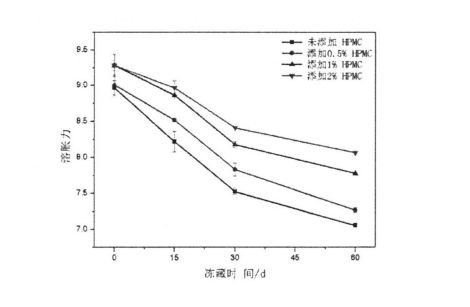
The gelatinization of starch is an endothermic chemical thermodynamic process. Therefore, DSC is often used to determine the onset temperature (Dead), peak temperature (To), end temperature (T p), and gelatinization enthalpy of starch gelatinization. (Tc). 4.4 වගුවේ දැක්වෙන්නේ පිෂ් ch ය ජෙලටින්කරණයේ ඩීඑස්සී වක්ර විවිධ කැටි ගබඩා වේලාවන් සඳහා HPMC නොමැතිව ය.
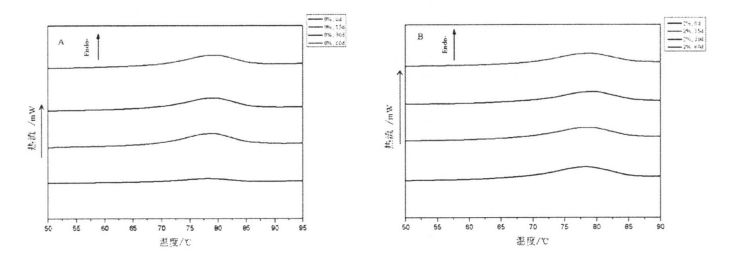
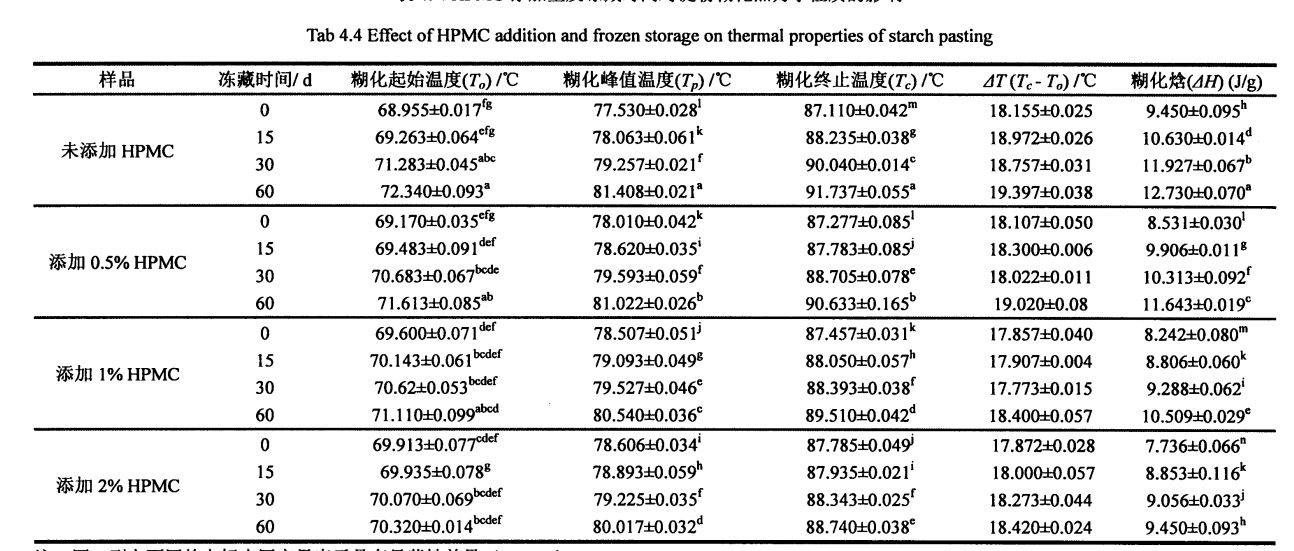
4.4 වගුවේ පෙන්වා ඇති පරිදි, නැවුම් ඇමයිලොයිඩ්, එච්.පී.එම්.සී. HPMC), but 4H is significant Decrease, from 9.450 ± 0.095 (without adding HPMC) to 8.53 ± 0.030 (adding 0.5% HPMC), 8.242A: 0.080 (adding 1% HPMC) and 7 .736 ± 0.066 (add 2% HPMC). මෙය ෂෝ, සහ ඒ 1 ට සමාන වේ. (2008) found that adding a hydrophilic colloid decreased the starch gelatinization enthalpy and increased the starch gelatinization peak temperature [172]. මෙයට ප්රධාන වශයෙන් වන්නේ HPMC වඩා හොඳ හයිඩ්රොෆිලිකරවීමට වඩා හොඳ හයිඩ්රොෆිලික්තාවයක් ඇති අතර පිෂ් .යට වඩා ජලය සමඟ ඒකාබද්ධ කිරීම පහසුය. At the same time, due to the large temperature range of the thermally accelerated gelation process of HPMC, the addition of HPMC increases the peak gelatinization temperature of starch, while the gelatinization Enthalpy decreases.
අනෙක් අතට, පිෂ් ch ය ජෙලටින්කරණය, ටී පී, ටීසී, ටීසී, ටී, ටීසී, ටී, ටීසී, ටීසී, Specifically, starch gelatinization with 1% or 2% HPMC added had no significant difference after freezing for 60 days, while starch without or with 0.5% HPMC was added from 68.955±0.01 7 (frozen storage for 0 days) increased to 72.340 ± 0.093 (frozen storage for 60 days), and from 69.170 ± 0.035 (frozen storage for 0 days) to 71.613 ± 0.085 (දින 0 ක් සඳහා ශීත කළ ආචයනය) දින 60 ක්); after 60 days of frozen storage, the growth rate of starch gelatinization decreased with the increase of HPMC addition, such as starch without HPMC added from 77.530 ± 0.028 (frozen storage for 0 days) to 81.028. 408 ± 0.021 (frozen storage for 60 days), while the starch added with 2% HPMC increased from 78.606 ± 0.034 (frozen storage for 0 days) to 80.017 ± 0.032 (frozen storage for 60 days). days); in addition, ΔH also showed the same change rule, which increased from 9.450 ± 0.095 (no addition, 0 days) to 12.730 ± 0.070 (no addition, 60 days), respectively, from 8.450 ± 0.095 (no addition, 0 days) to 12.730 ± 0.070 (no addition, 60 days), respectively. 531 ± 0.030 (දින 0.5%, 0 ක් එකතු කරන්න). The main reasons for the above-mentioned changes in the thermodynamic properties of starch gelatinization during the frozen storage process are the formation of damaged starch, which destroys the amorphous region (amorphous region) and increases the crystallinity of the crystalline region. The coexistence of the two increases the relative crystallinity of starch, which in turn leads to an increase in thermodynamic indexes such as starch gelatinization peak temperature and gelatinization enthalpy. However, through comparison, it can be found that under the same freezing storage time, with the increase of HPMC addition, the increase of starch gelatinization To, T p, Tc, ΔT and ΔH gradually decreases. It can be seen that the addition of HPMC can effectively maintain the relative stability of the starch crystal structure, thereby inhibiting the increase of the thermodynamic properties of starch gelatinization.
4.3.7 I-IPMC, පිෂ් ch යේ සාපේක්ෂ ස් stal ටිකරූපීතාවයේ කැටි ගබඩා කිරීමේ කාලය හා කැටි කිරීමේ කාලය
However, with the prolongation of freezing storage time, the relative crystallinity of starch increased from 20.40 + 0.14 (without HPMC, 0 days) to 36.50 ± 0.42 (without HPMC, frozen storage, respectively). 60 days), and increased from 25.75 + 0.21 (2% HPMC added, 0 days) to 32.70 ± 0.14 (2% HPMC added, 60 days) (Figure 4.6.B), this and Tao, et a1. (2016), the change rules of the measurement results are consistent [173-174]. සාපේක්ෂ ස් stal ටිකරූපීතාවයේ වැඩිවීම ප්රධාන වශයෙන් හේතු වී ඇත්තේ අමෝෆස් කලාපය විනාශ වීම සහ ස් stal ටිකරූපී කලාපයේ ස් stal ටිකරූපීතාවයේ වැඩිවීම හේතුවෙනි. In addition, consistent with the conclusion of the changes in the thermodynamic properties of starch gelatinization, the addition of HPMC reduced the degree of relative crystallinity increase, which indicated that during the freezing process, HPMC could effectively inhibit the structural damage of starch by ice crystals and maintain the Its structure and properties are relatively stable.
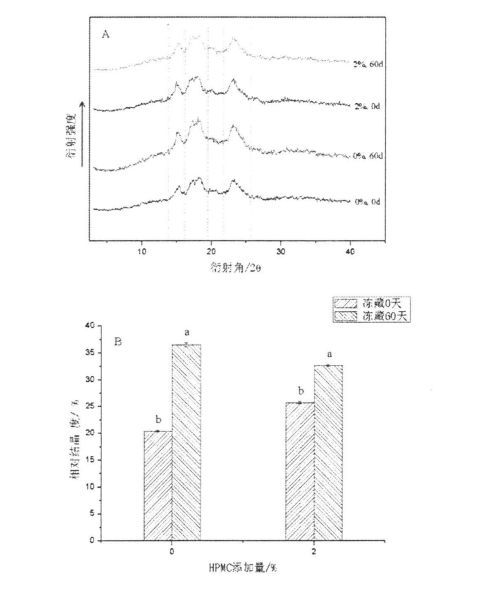
FIL 4.6 HPMC එකතු කිරීමේ බලපෑම සහ XRD ගුණාංගවල ශීත කළ ආචයනය
Note: A is x. එක්ස් කිරණ විවර්තන රටාව; B is the relative crystallinity result of starch;
Starch is the most abundant dry matter in dough, which, after gelatinization, adds unique qualities (specific volume, texture, sensory, flavor, etc.) to the dough product. Since the change of starch structure will affect its gelatinization characteristics, which will also affect the quality of flour products, in this experiment, the gelatinization characteristics, flowability and flowability of starch after frozen storage were investigated by examining starch suspensions with different contents of HPMC added. Changes in rheological properties, thermodynamic properties and crystal structure were used to evaluate the protective effect of HPMC addition on starch granule structure and related properties. පර්යේෂණාත්මක ප්රති results ලවලින් පෙනී ගියේ දින 60 ක ශීත කළ ආචයනයෙන් පසුව, පිෂ් ch යේ සාපේක්ෂ ස්ත්රියෙහි සාපේක්ෂ ස්ත්රියෙහි සැලකිය යුතු වැඩි වීමක් සහ හානියට පත් පිෂ් .යේ අන්තර්ගතය වැඩි වීම නිසා සියල්ල වැඩි වී ඇති බවයි. The gelatinization enthalpy increased, while the gel strength of starch paste decreased significantly; however, especially the starch suspension added with 2% HPMC, the relative crystallinity increase and starch damage degree after freezing were lower than those in the control group Therefore, the addition of HPMC reduces the degree of changes in gelatinization characteristics, gelatinization enthalpy, and gel strength, which indicates that the addition of HPMC keeps the starch structure and its gelatinization properties relatively stable.
එච්.පී.එම්.සී.
ශීත කළ ආචයනය සම්බන්ධයෙන්, යීස්ට් පාරිසරික ආතතියෙන් පෙළෙන අතර එහි ශක්යතාවයට බලපානු ඇත. කැටි කිරීමේ අනුපාතය වැඩියි, පද්ධතියේ ජලය යීස්ට් වල බාහිර ඔස්මොටික් පීඩනය වේගයෙන් ස් st න්නේ ය යීස්ට් වල බාහිර ඔස්මොටික් පීඩනය වැඩි කරයි, එමඟින් සෛලවල ජලය නැති වේ; කැටි අනුපාතය වැඩියි. එය ඉතා අඩු නම්, අයිස් ස් st ටික ඉතා විශාල වන අතර යීස්ට් මිරිකනු ඇති අතර සෛල බිත්තියට හානි සිදුවනු ඇත; both will reduce the survival rate of the yeast and its fermentation activity. In addition, many studies have found that after the yeast cells are ruptured due to freezing, they will release a reducing substance-reduced glutathione, which in turn reduces the disulfide bond to a sulfhydryl group, which will eventually destroy the network structure of gluten protein, resulting in a decrease in the quality of pasta products [176-177].
HPMC ශක්තිමත් ජල රඳවා තබා ගැනීම සහ ජලයේ ජල ධාරිතාව ඇති නිසා, පිටි ගුලිය පද්ධතියට එකතු කිරීම අයිස් ස් st ටික සෑදීම හා වර්ධනය වීම වළක්වයි. In this experiment, different amounts of HPMC were added to the dough, and after a certain period of time after frozen storage, the quantity of yeast, fermentation activity and glutathione content in unit mass of dough were determined to evaluate the protective effect of HPMC on yeast under freezing conditions.
BDS. ප්රතිලෝම ජීව විද්යාත්මක අන්වීක්ෂය
නිෂ්පාදකයා
ඇමරිකා එක්සත් ජනපදයේ 3M සංස්ථාව
සීමාසහිත ජියැන්ගු ටොජිං පවිත්රා උපකරණ සමාගම
The alloxan method was used to determine the glutathione content. The principle is that the reaction product of glutathione and alloxan has an absorption peak at 305 nl. Specific determination method: pipette 5 mL of yeast solution into a 10 mL centrifuge tube, then centrifuge at 3000 rpm for 10 min, take 1 mL of supernatant into a 10 mL centrifuge tube, add 1 mL of 0.1 mol/mL to the tube L alloxan solution, mixed thoroughly, then add 0.2 M PBS (pH 7.5) and 1 mL of 0.1 M, NaOH solution to it, mix well, let stand for 6 min, and immediately add 1 M, NaOH The solution was 1 mL, and the absorbance at 305 nm was measured with a UV spectrophotometer after thorough mixing. The glutathione content was calculated from the standard curve. සෑම නියැදියක්ම තුන් වතාවක් සමාන්තර විය.
5.2.2.5 දත්ත සැකසීම
5.3.1 HPMC එකතු කිරීමේ අතිරේක මුදල සහ ඇනූ සනාථ කිරීමේ උස පිළිබඳ ශීත කළ ගබඩා කාලය
ඇනූ වල සනාථ කිරීමේ උස බොහෝ විට යීස්ට් පැසවීම සහ ඇනූ ජාල ව්යුහය ශක්තිය ඒකාබද්ධ බලපෑමෙන් බලපායි. Among them, yeast fermentation activity will directly affect its ability to ferment and produce gas, and the amount of yeast gas production determines the quality of fermented flour products, including specific volume and texture. The fermentation activity of yeast is mainly affected by external factors (such as changes in nutrients such as carbon and nitrogen sources, temperature, pH, etc.) and internal factors (growth cycle, activity of metabolic enzyme systems, etc.).

As shown in Figure 5.1, when frozen for 0 days, with the increase in the amount of HPMC added, the proofing height of the dough increased from 4.234-0.11 cm to 4.274 cm without adding HPMC. -0.12 cm (0.5% HPMC added), 4.314-0.19 cm (1% HPMC added), and 4.594-0.17 cm (2% HPMC added) This may be mainly due to HPMC Addition changes the properties of the dough network structure (see Chapter 2). කෙසේ වෙතත්, දින 60 ක් ශීත කළ පසු, ඇනූ වල සනාථ කිරීමේ උස වෙනස් වෙමින් පවතී. විශේෂයෙන්, HPMC නොමැතිව ඇනූ වල සනාථ වූ උස සෙවීම 4.234-011 සිට සෙ.මී. the dough added with 0.5% HPMC was reduced from 4.27+0.12 cm (frozen storage for 0 days) to 3.424-0.22 cm (frozen storage for 0 days). 60 days); the dough added with 1% HPMC decreased from 4.314-0.19 cm (frozen storage for 0 days) to 3.774-0.12 cm (frozen storage for 60 days); while the dough added with 2% HPMC woke up. The hair height was reduced from 4.594-0.17 cm (frozen storage for 0 days) to 4.09-±0.16 cm (frozen storage for 60 days). එච්පීඑම්සී එකතු කිරීමේ එකතු කිරීම වැඩිවීමත් සමඟ ඇනූ වල සනාථ කිරීමේ උසෙහි අඩුවීමක් ක්රමයෙන් අඩු වන බව එය දැකිය හැකිය. ශීත කළ ගබඩාවේ කොන්දේසිය යටතේ, එච්.පී.එම්.සී. හි, එච්.පී.එම්.සී.
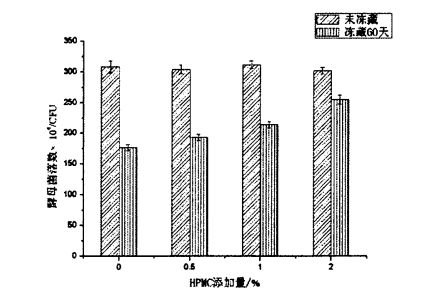
එච්.පී.එම්.සී.
It can be seen from Figure 5.2 that there is no significant difference in the number of yeast colonies in samples with different contents of HPMC added without freezing treatment. මෙය හිට්මන්, සැන්නිනි, සාන්මිනි සහ අරෙන්ඩ් (2015) විසින් තීරණය කරන ලද ප්රති result ලයට සමාන වේ. However, after 60 days of freezing, the number of yeast colonies decreased significantly, from 3.08x106 CFU to 1.76x106 CFU (without adding HPMC); 3.04x106 CFU සිට 193x106 CFU දක්වා (0.5% HPMC එකතු කිරීම); reduced from 3.12x106 CFU to 2.14x106 CFU (added 1% HPMC); 3.02x106 CFU සිට 2.55x106 CFU දක්වා අඩු කර ඇත (2% HPMC). සංසන්දනය කිරීමෙන්, කැටි ගබඩා පරිසරද ආතතිය යීස්ට් ජනපද අංකය අඩුවීමට හේතු වූ නමුත් HPMC එකතු කිරීමේ වැඩිවීමත් සමඟ, යටත් විජිත අංකය අඩු කිරීමේ තරම. This indicates that HPMC can better protect yeast under freezing conditions. The mechanism of protection may be the same as that of glycerol, a commonly used strain antifreeze, mainly by inhibiting the formation and growth of ice crystals and reducing the stress of low temperature environment to yeast. Figure 5.3 is the photomicrograph taken from the 3M yeast rapid counting test piece after preparation and microscopic examination, which is in line with the external morphology of yeast.
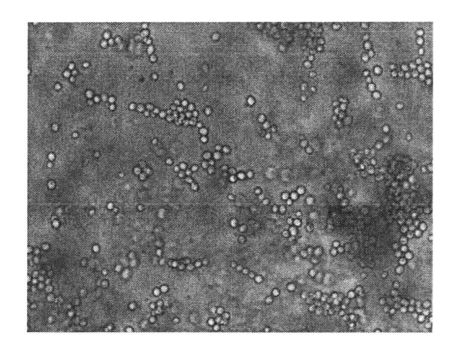
5.3.3 ඇනූ වල ග්ලූතියනේ අන්තර්ගතයේ HPMC එකතු කිරීම සහ කැටි කාලය
Glutathione is a tripeptide compound composed of glutamic acid, cysteine and glycine, and has two types: reduced and oxidized. When the yeast cell structure is destroyed and died, the permeability of the cells increases, and the intracellular glutathione is released to the outside of the cell, and it is reductive. ග්ලූටන් ප්රෝටීන වල හරස්-සම්බන්ධතාවය හරස් සම්බන්ධ කිරීම මගින් ග්ලූටිතාන් විසින් සිදු කරන ලද ඩිෆිෆයිඩ් බැඳුම්කර (-SS-) අඩු කිරීම, ඒවා නිදහස් සල්ෆෙයිත්රිල් කණ්ඩායම් (.SH) බවට පත් කිරීම වටී. stability and integrity, and ultimately lead to the deterioration of the quality of fermented flour products. සාමාන්යයෙන්, පාරිසරික ආතතිය යටතේ (අඩු උෂ්ණත්වය, ඉහළ උෂ්ණත්වය, ඉහළ උෂ්ණත්වය, ඉහළ වාදක පීඩනය ආදිය වැනි) යීස්ට් තමන්ගේම පරිවෘත්තීය ක්රියාකාරකමක් අඩු කරන අතර එහි ආතති ප්රතිරෝධය වැඩි කරයි හෝ ඒ සමඟම බීජාණු වැඩි කරයි. නැවත නැවතත් එහි වර්ධනය හා ප්රජනනය සඳහා පාරිසරික තත්ත්වයන් සුදුසු වන විට, පරිවෘත්තීය හා ව්යාප්ති ජීව ශක්තිය යථා තත්වයට පත් කරන්න. However, some yeasts with poor stress resistance or strong metabolic activity will still die if they are kept in a frozen storage environment for a long time.
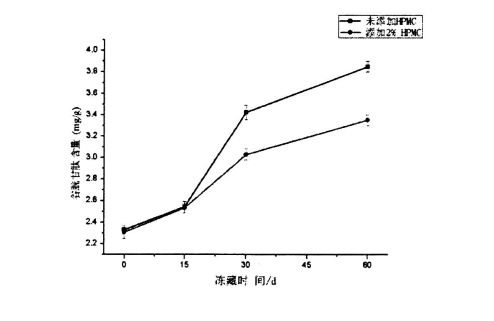
රූප සටහන 5.4 හි පෙන්වා ඇති පරිදි, HPMC එකතු කළ හෝ නැතත්, එතරම් වෙනස් සමානකම් අතර සැලකිය යුතු වෙනසක් නොතිබුණද ග්ලූටුති ගුණයන් වැඩි වූ අතර, විවිධ එකතු කිරීම් අතර සැලකිය යුතු වෙනසක් නොතිබුණි. This may be because some of the active dry yeast used to make the dough have poor stress resistance and tolerance. Under the condition of low temperature freezing, the cells die, and then glutathione is released, which is only related to the characteristics of the yeast itself. It is related to the external environment, but has nothing to do with the amount of HPMC added. එබැවින් ග්ලූතාතන්ගේ අන්තර්ගතය කැටි වී දින 15 ක් තුළ වැඩි වූ අතර මේ දෙක අතර සැලකිය යුතු වෙනසක් සිදු නොවීය. However, with the further extension of the freezing time, the increase of glutathione content decreased with the increase of HPMC addition, and the glutathione content of the bacterial solution without HPMC was increased from 2.329a: 0.040mg/ g (frozen storage for 0 days) increased to 3.8514-0.051 mg/g (frozen storage for 60 days); while the yeast liquid added 2% HPMC, its glutathione content increased from 2.307+0 .058 mg/g (frozen storage for 0 days) rose to 3.351+0.051 mg/g (frozen storage for 60 days). This further indicated that HPMC could better protect yeast cells and reduce the death of yeast, thereby reducing the content of glutathione released to the outside of the cell. This is mainly because HPMC can reduce the number of ice crystals, thereby effectively reducing the stress of ice crystals to yeast and inhibiting the increase of extracellular release of glutathione.
Yeast is an indispensable and important component in fermented flour products, and its fermentation activity will directly affect the quality of the final product. In this experiment, the protective effect of HPMC on yeast in frozen dough system was evaluated by studying the effect of different HPMC additions on yeast fermentation activity, yeast survival number, and extracellular glutathione content in frozen dough. Through experiments, it was found that the addition of HPMC can better maintain the fermentation activity of the yeast, and reduce the degree of decline in the proofing height of the dough after 60 days of freezing, thus providing a guarantee for the specific volume of the final product; in addition, the addition of HPMC effectively The decrease of yeast survival number was inhibited and the increase rate of reduced glutathione content was reduced, thereby alleviating the damage of glutathione to dough network structure. මෙයින් ඇඟවෙන්නේ අයිස් ස් st ටික සෑදීම හා වර්ධනය වීම වළක්වා ගැනීමෙන් HPMC විසින් යීස්ට් ආරක්ෂා කළ හැකි බවයි.
පශ්චාත් කාලය: ඔක්තෝබර් -80-2022







